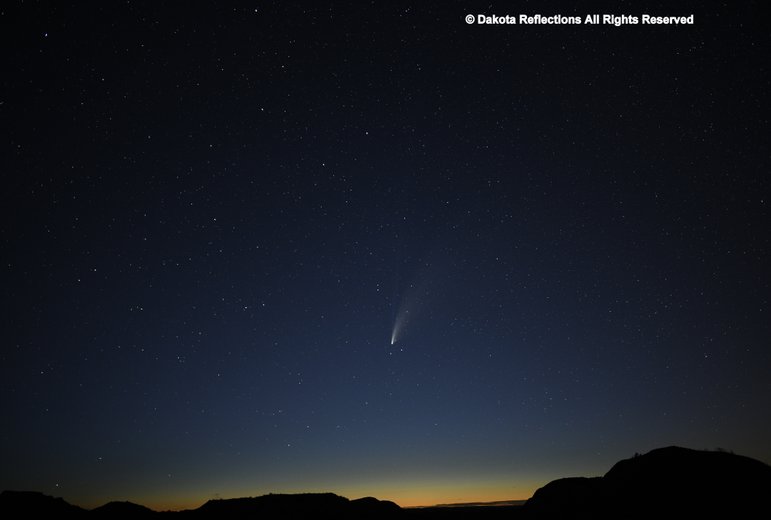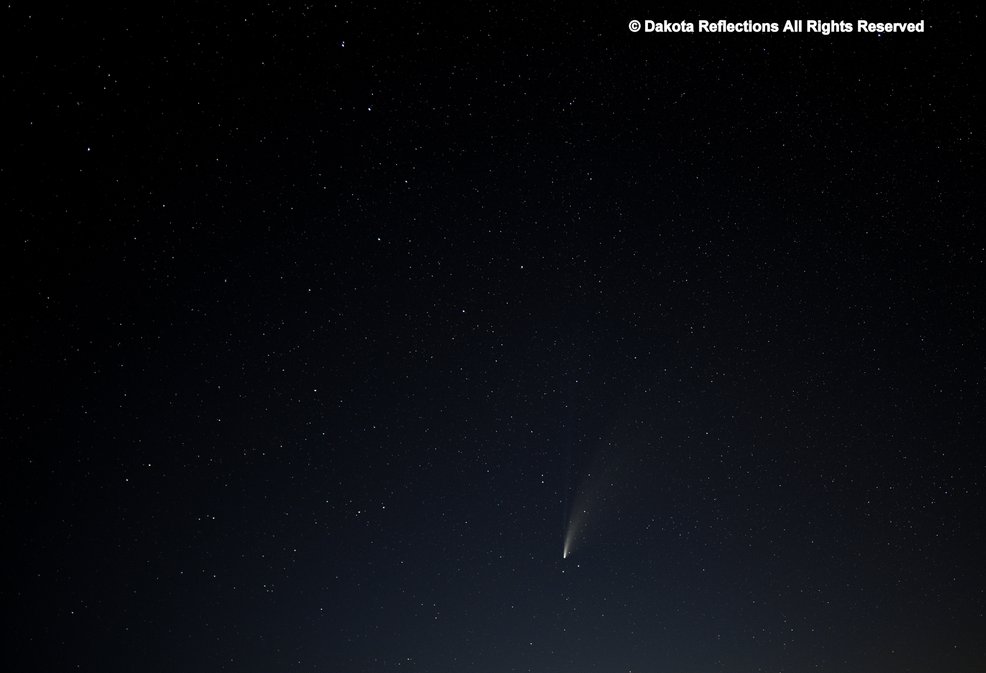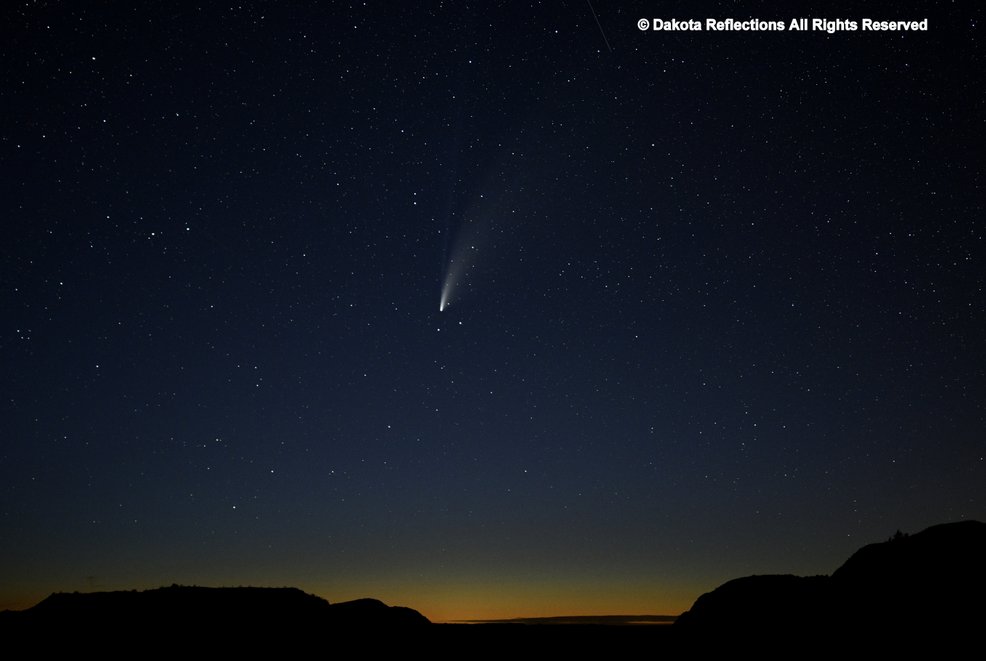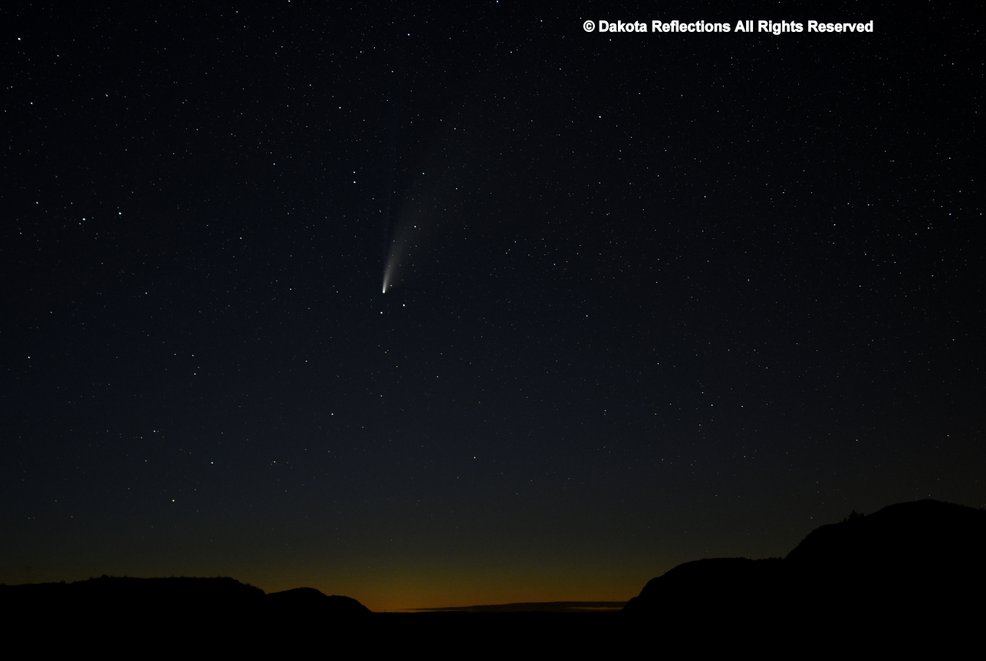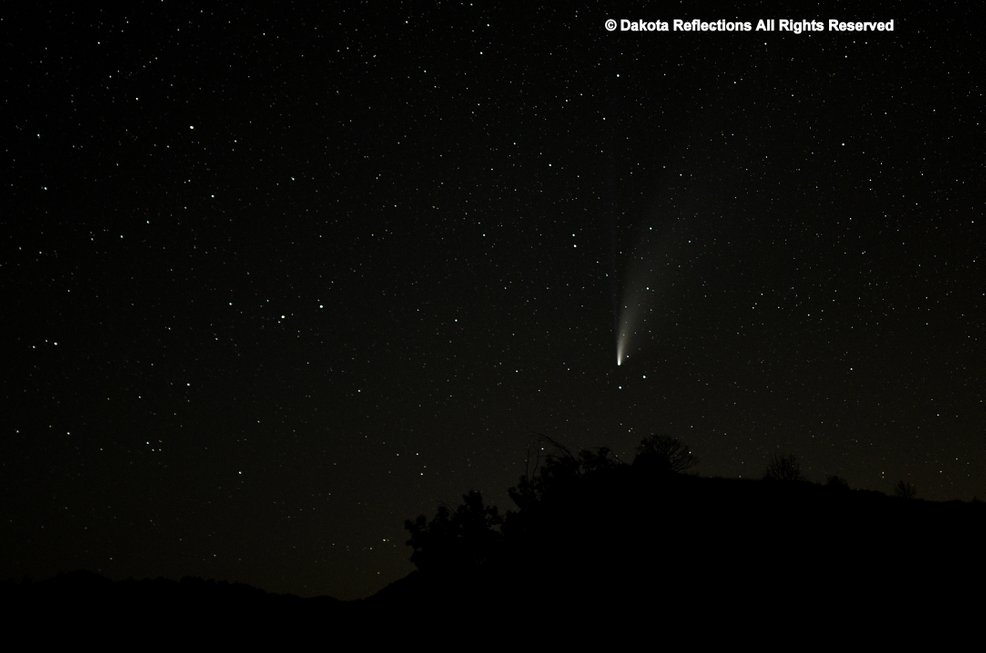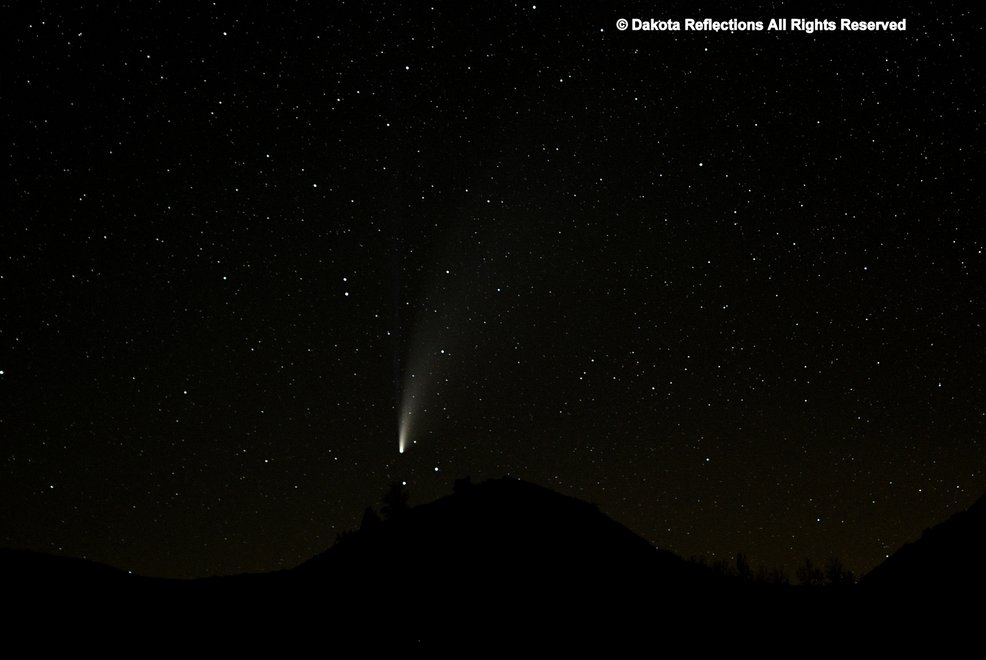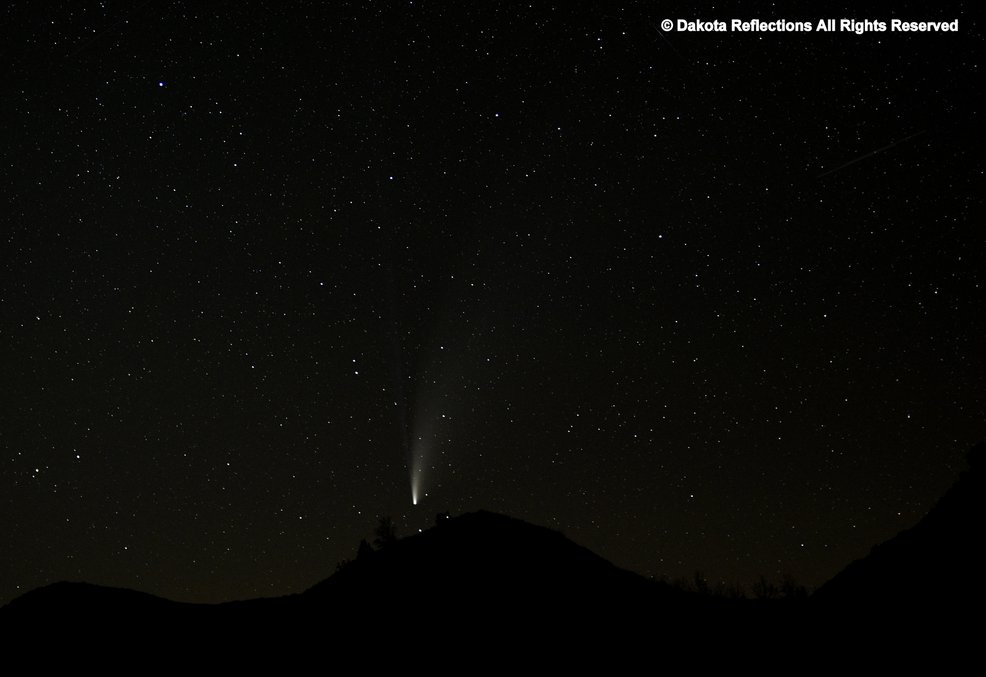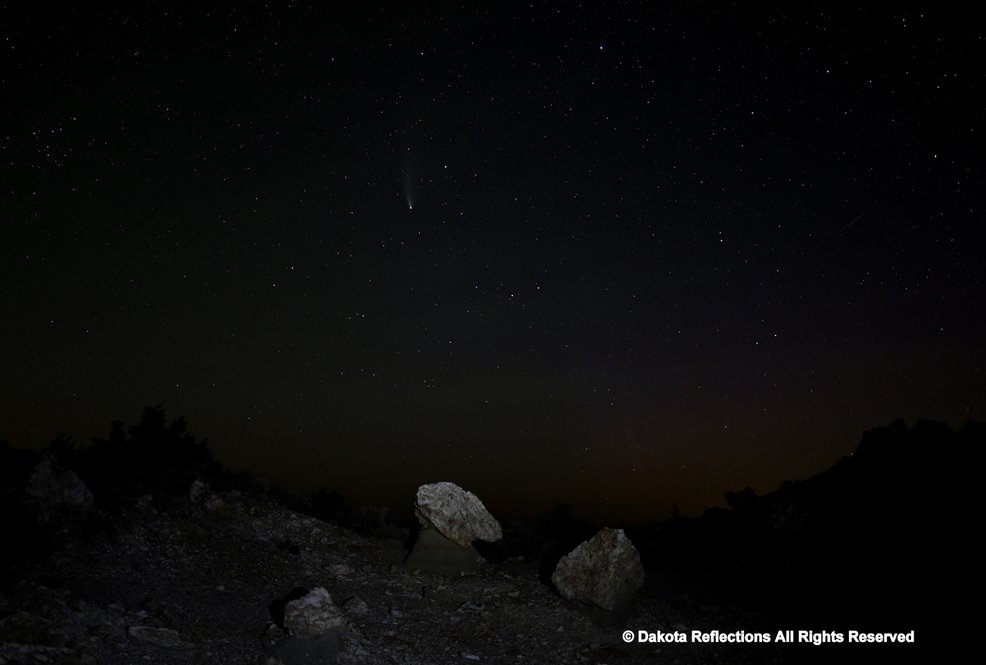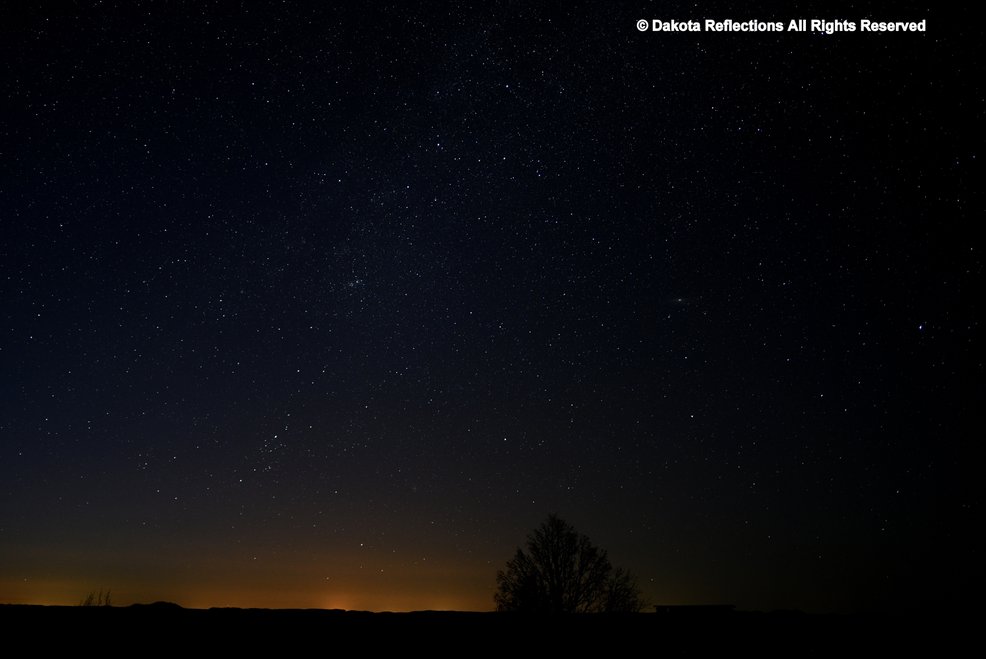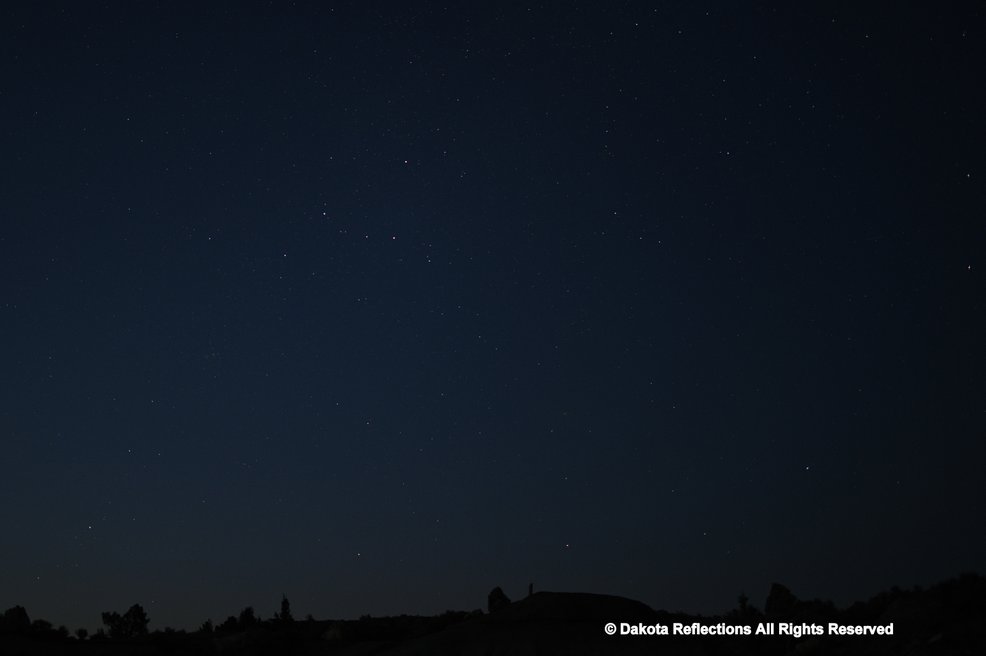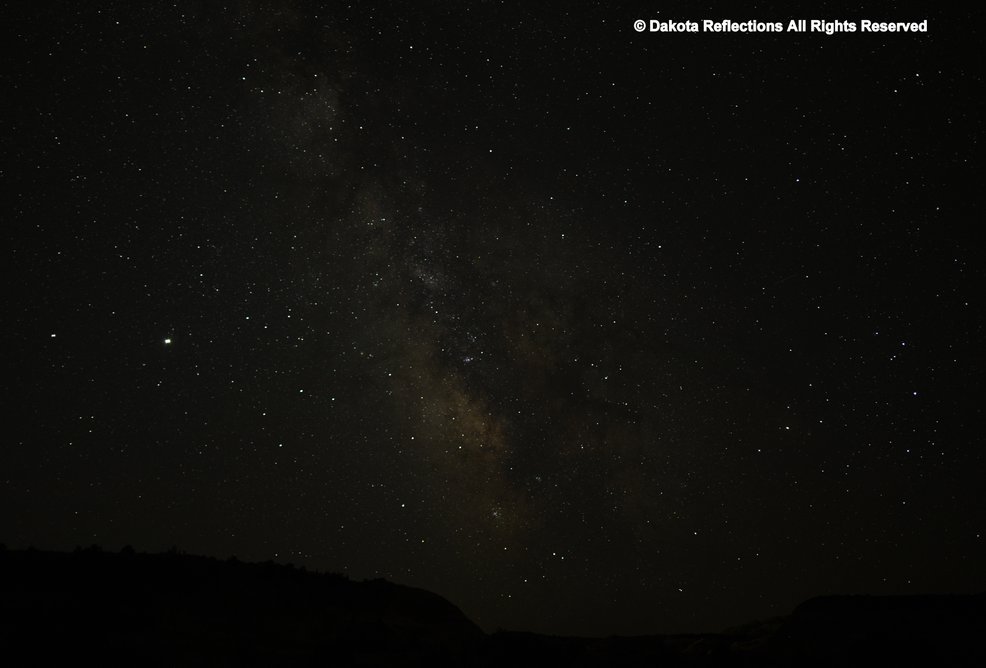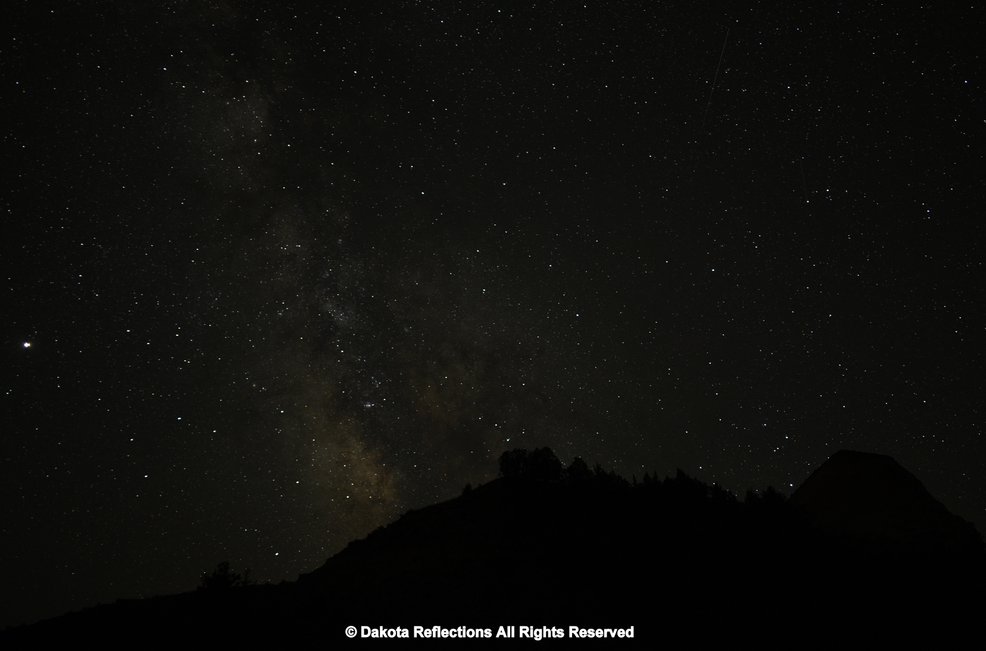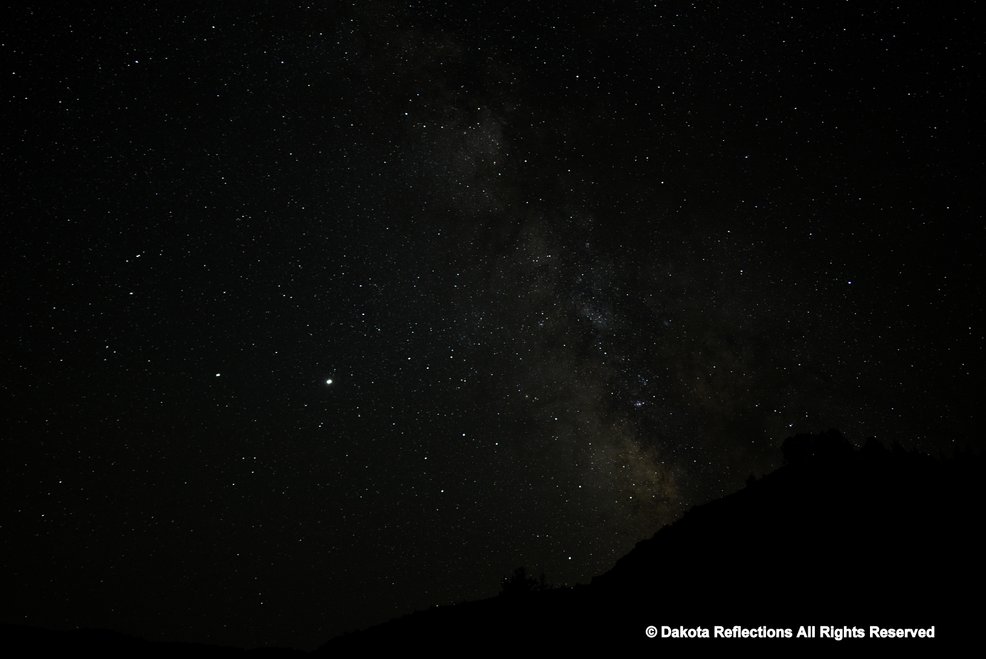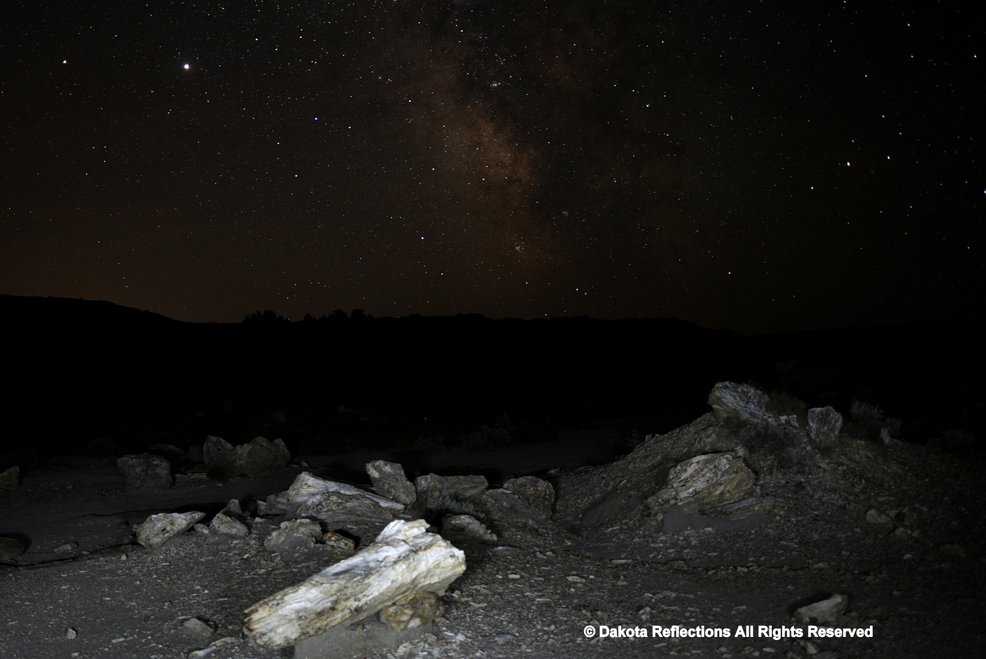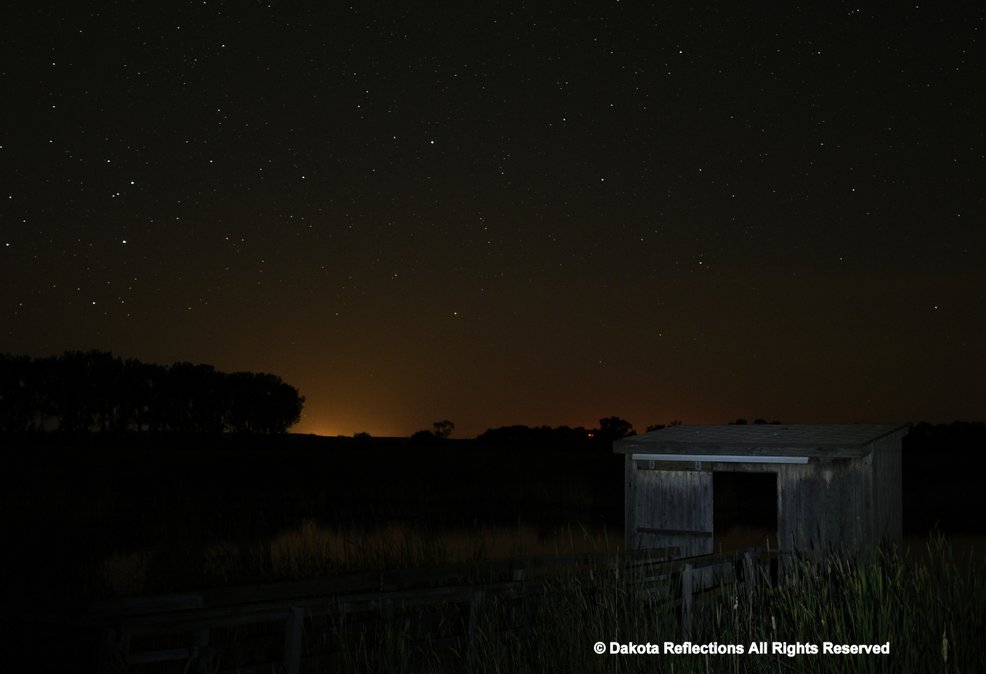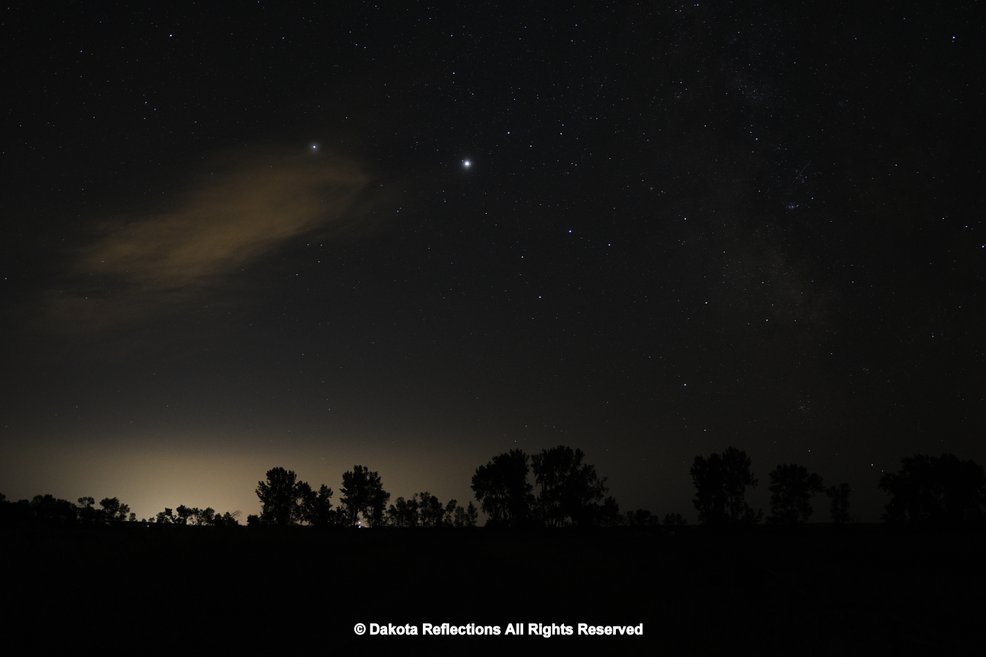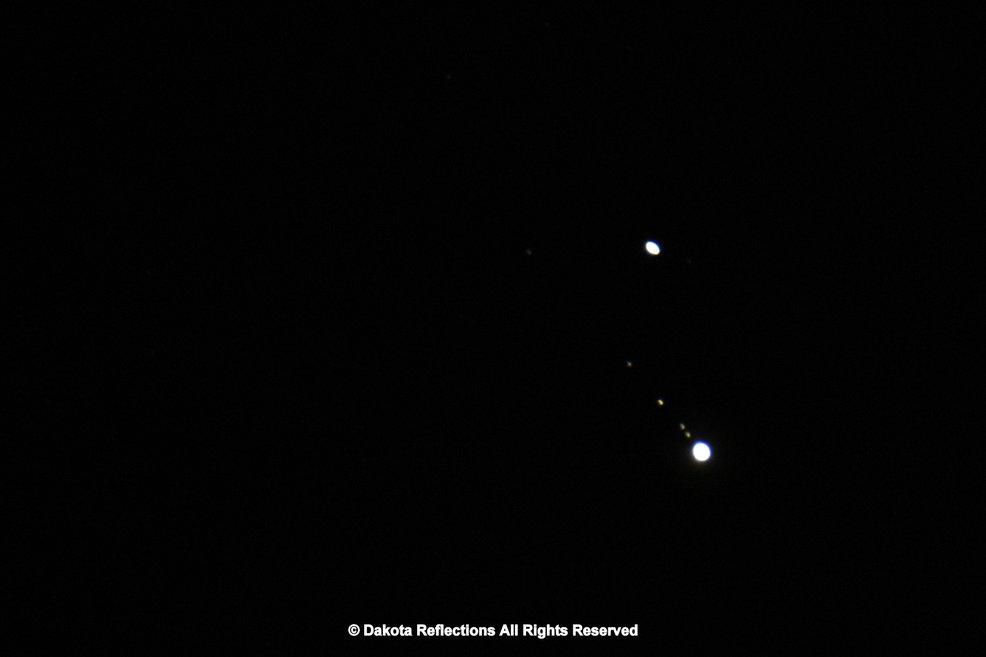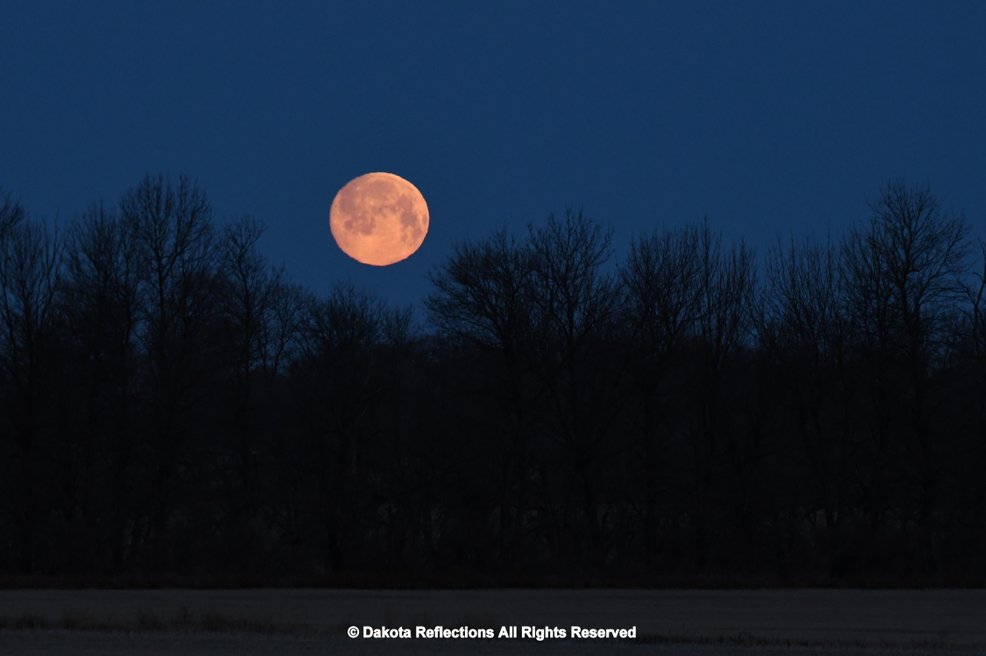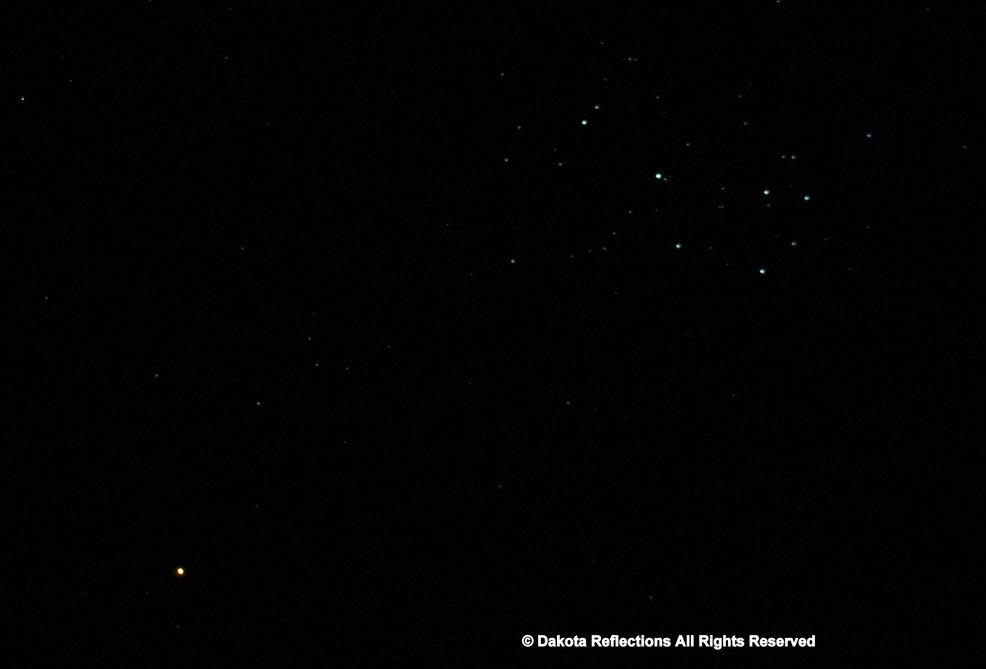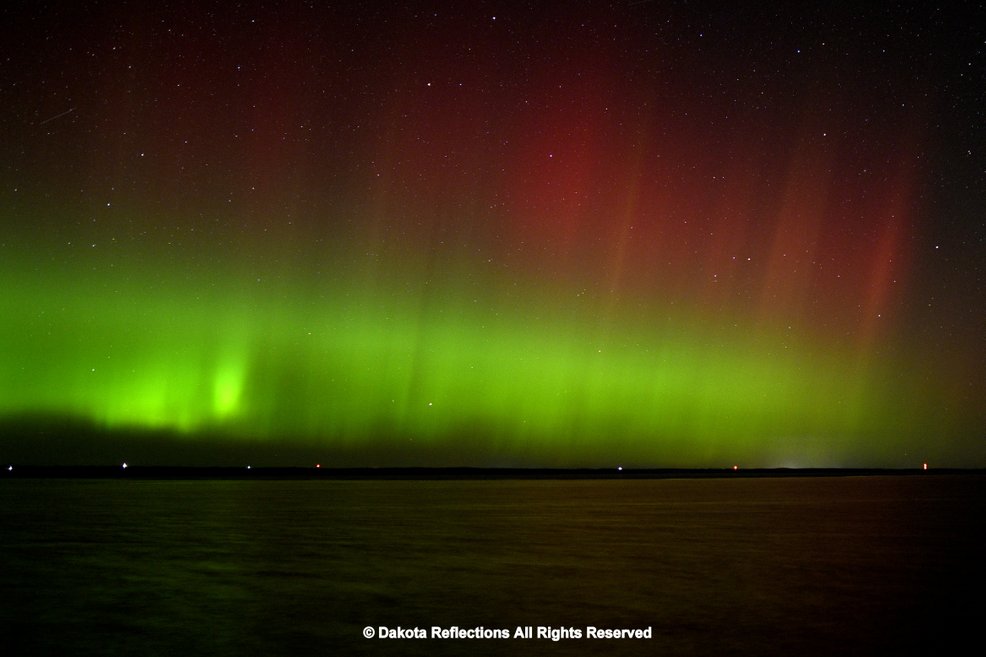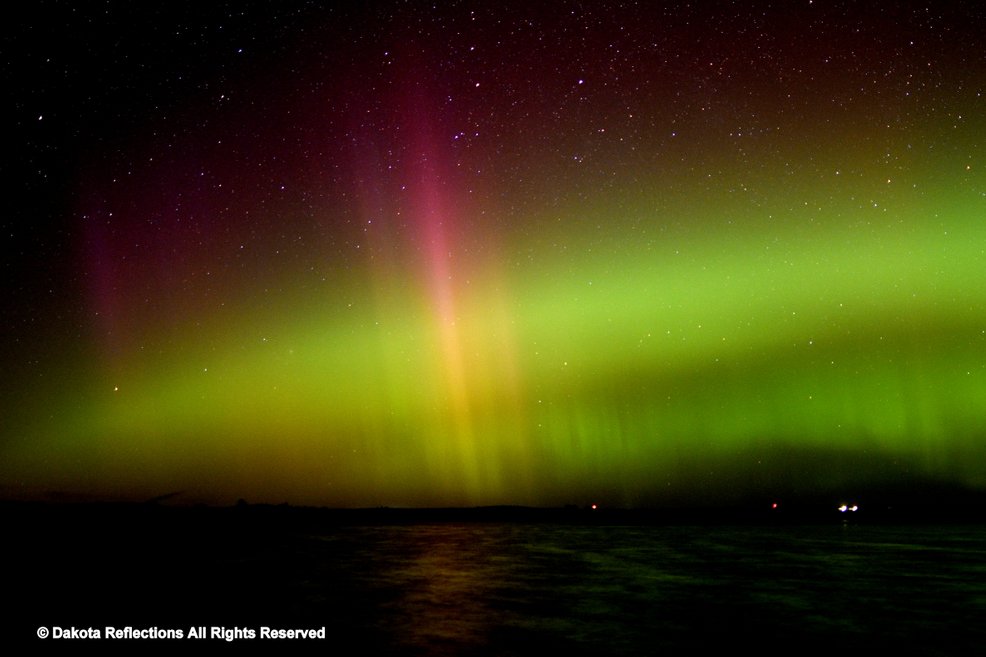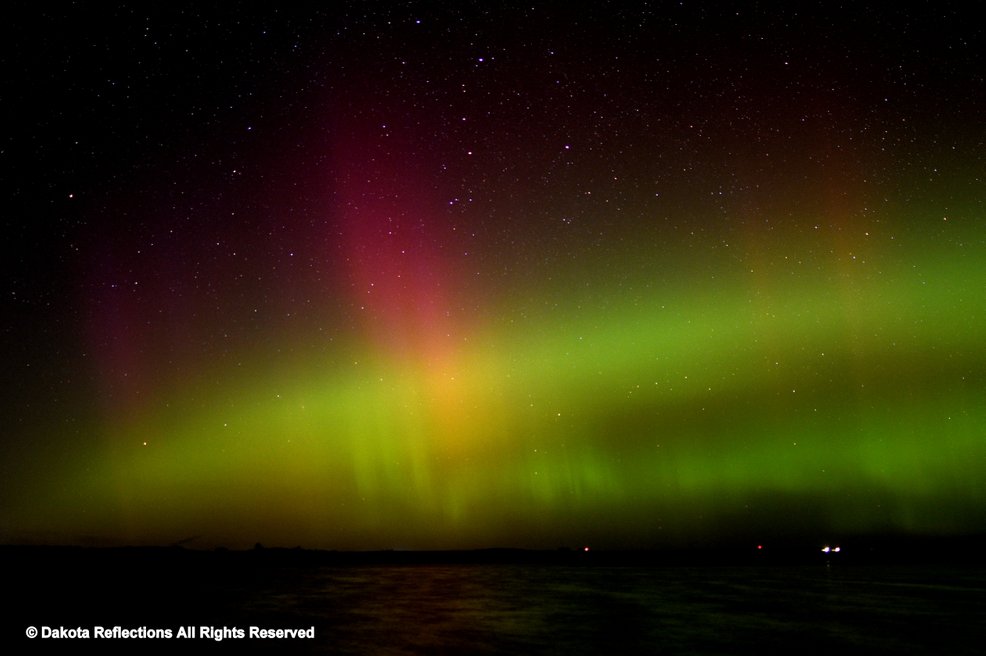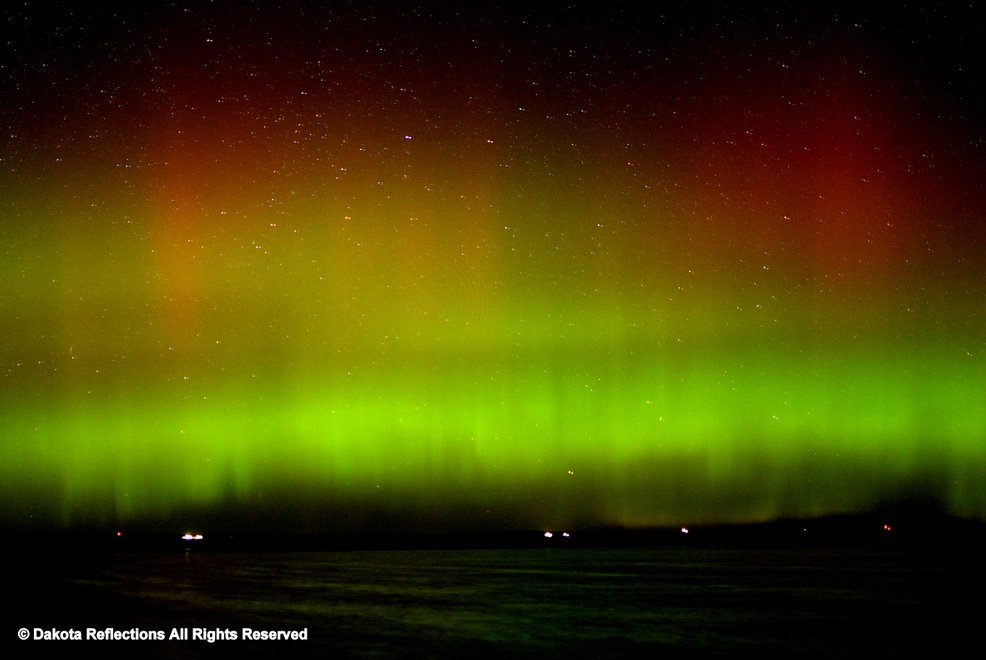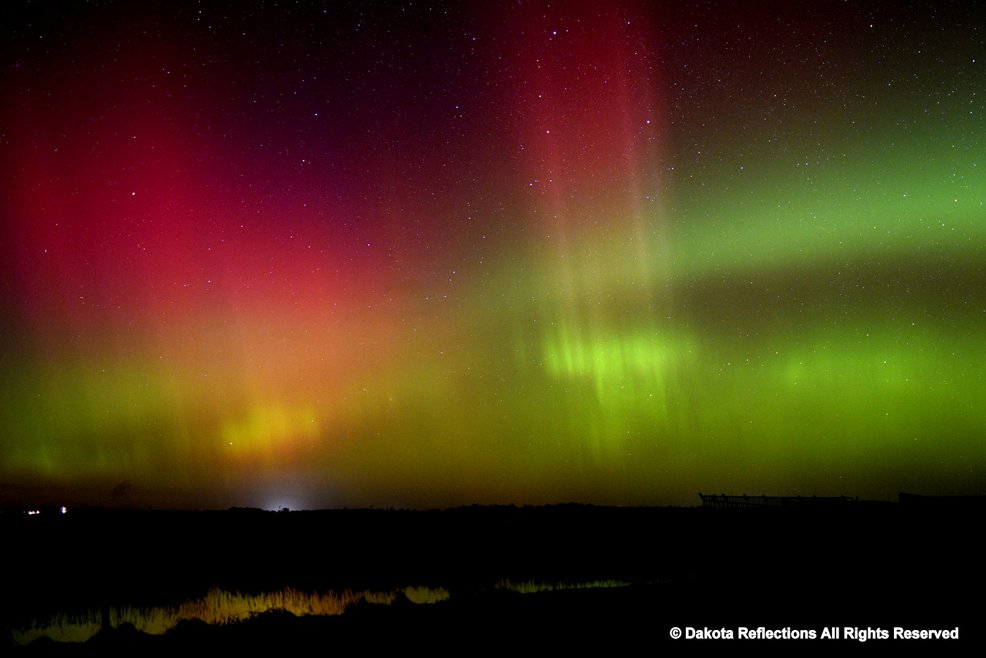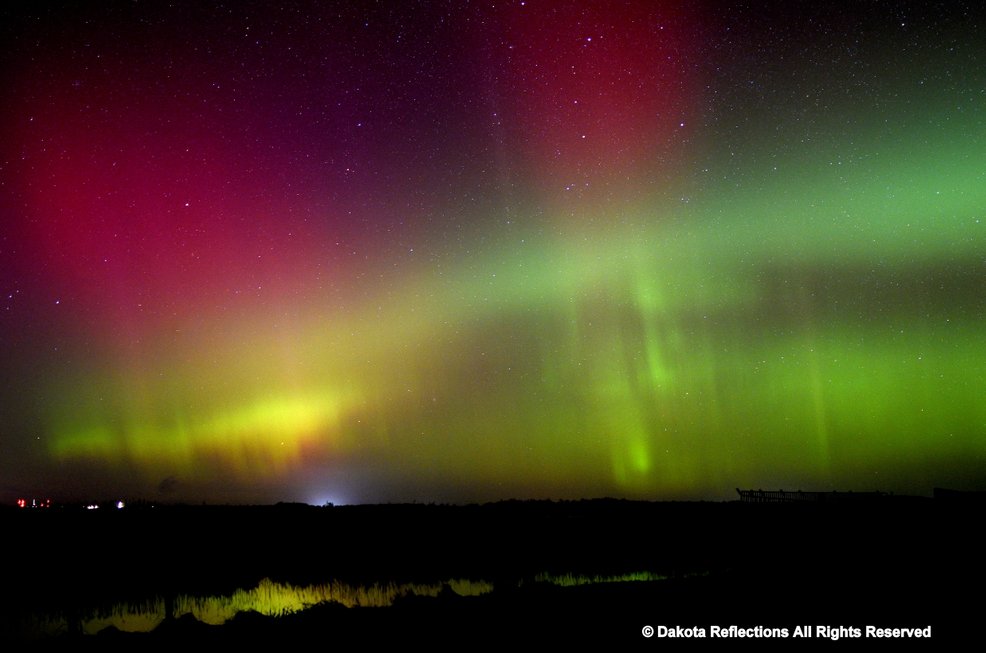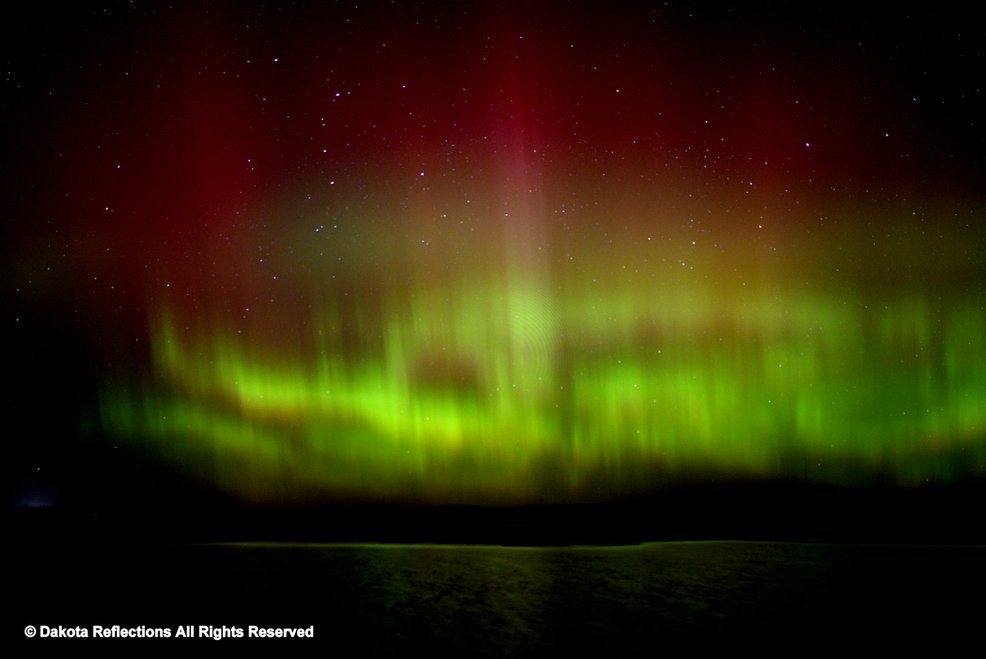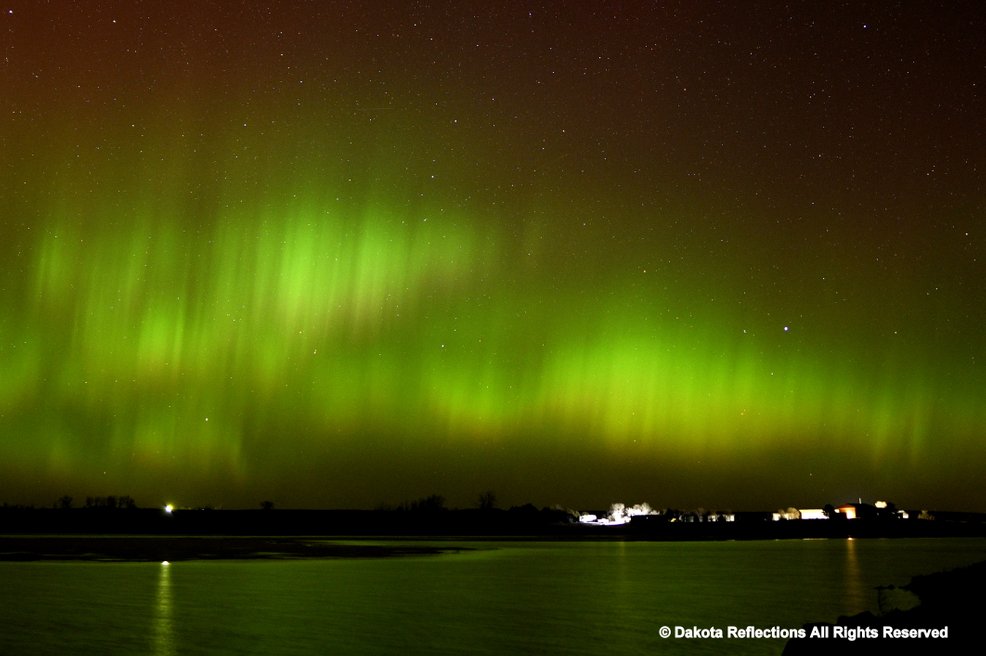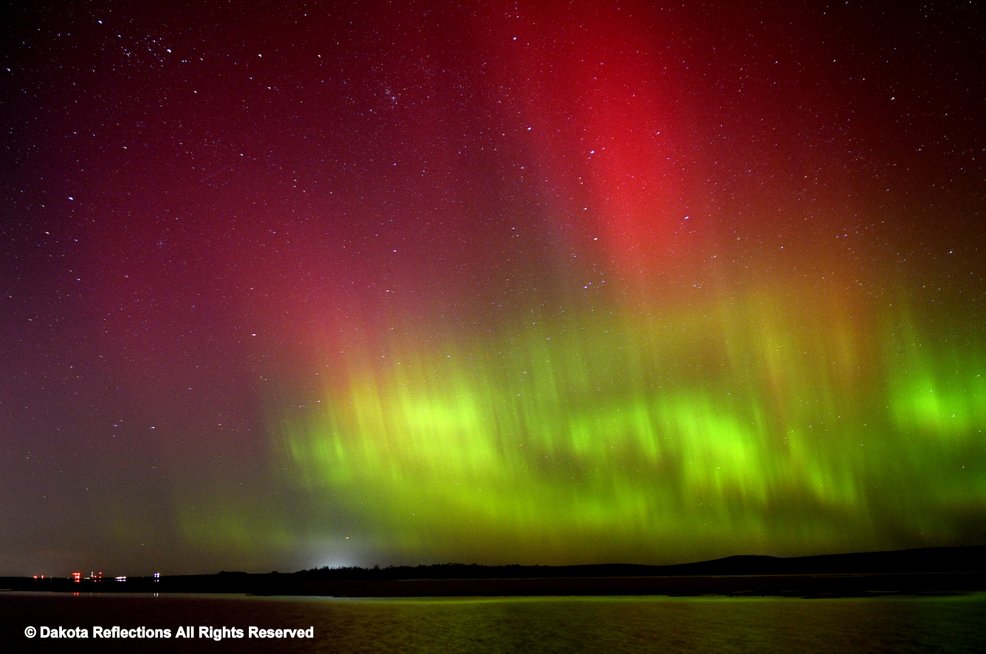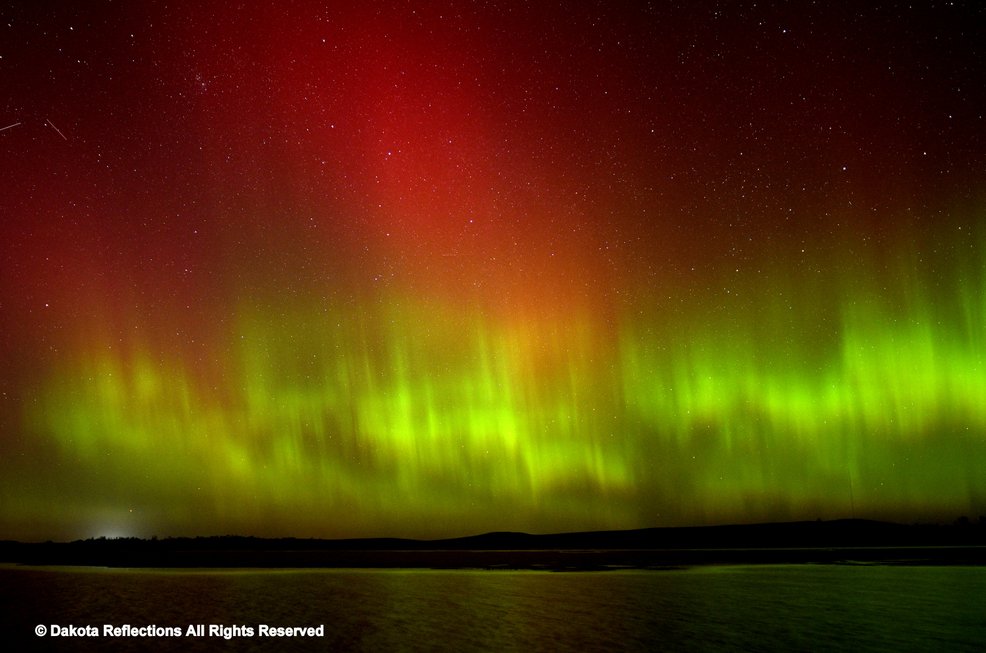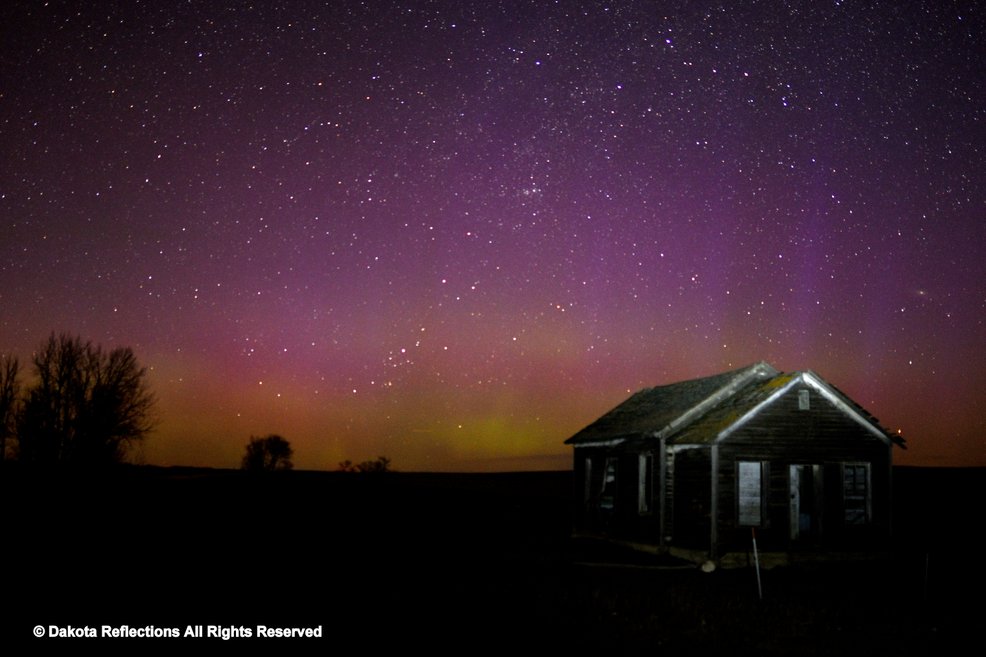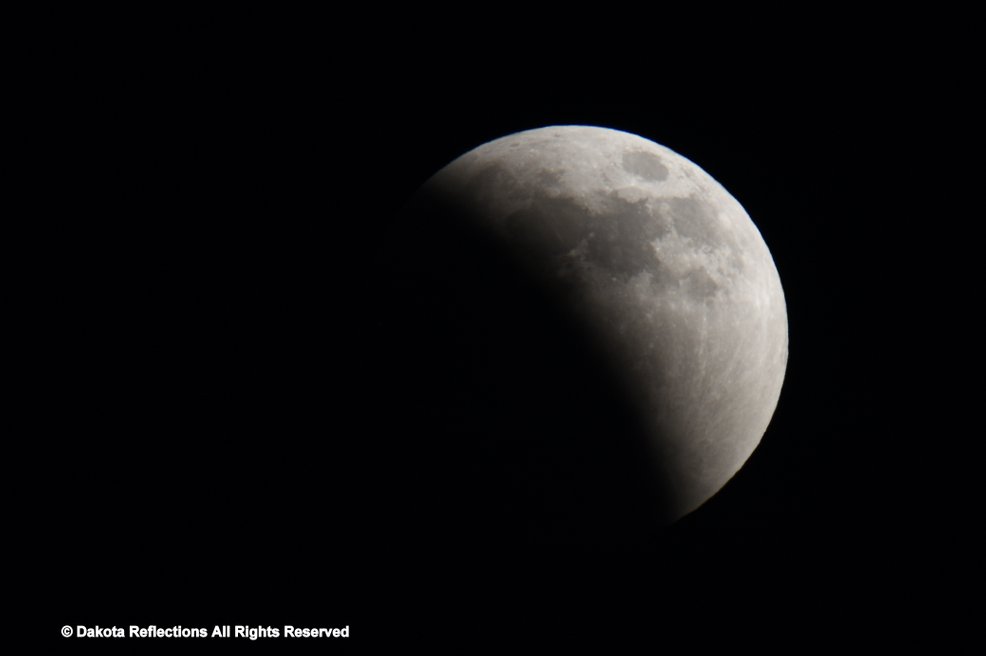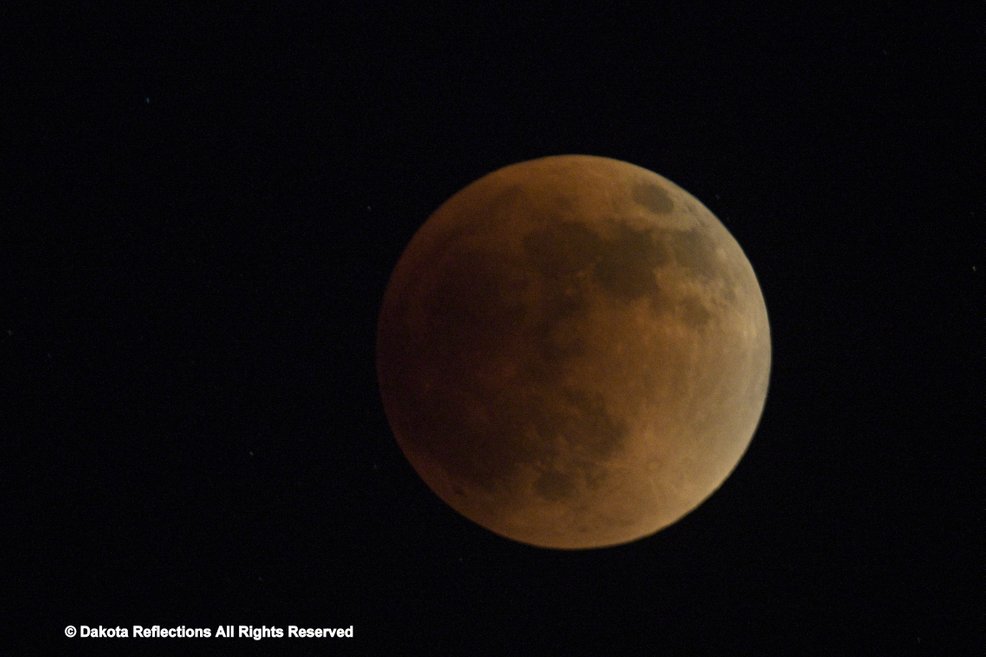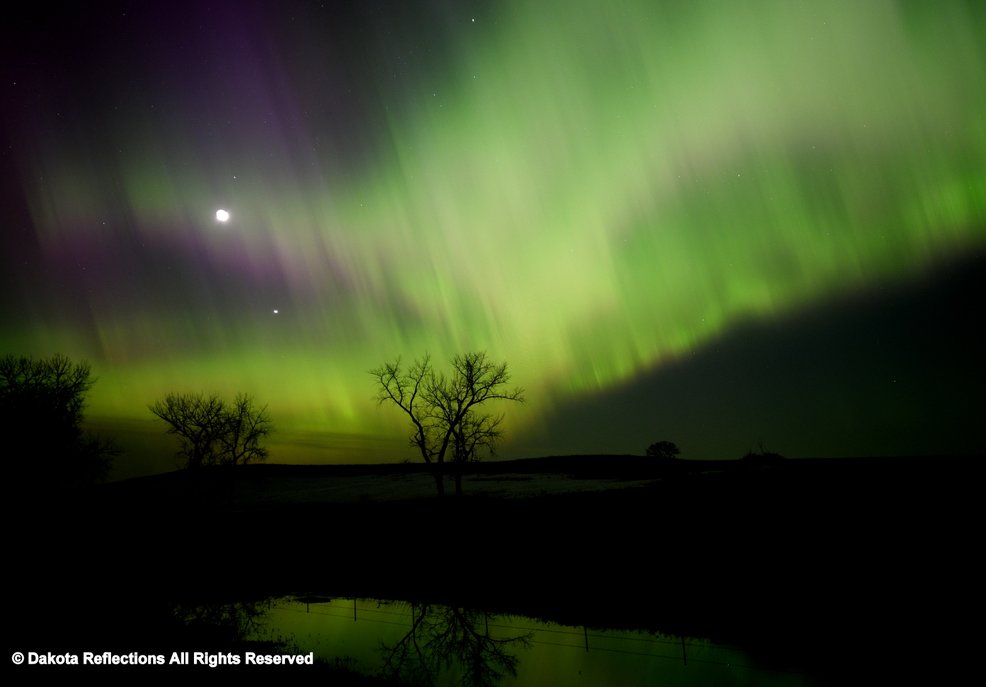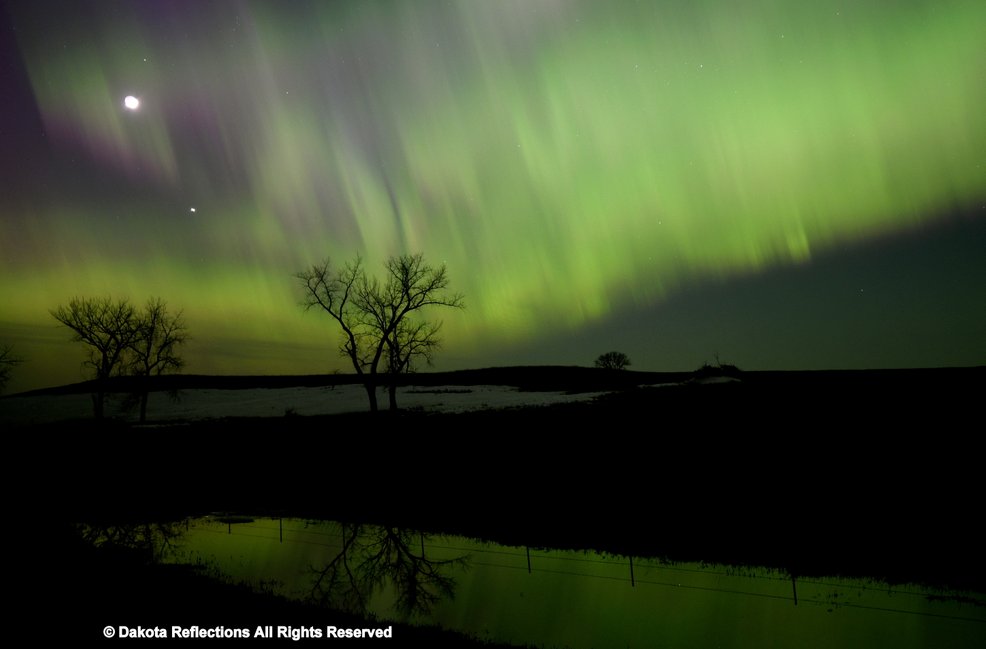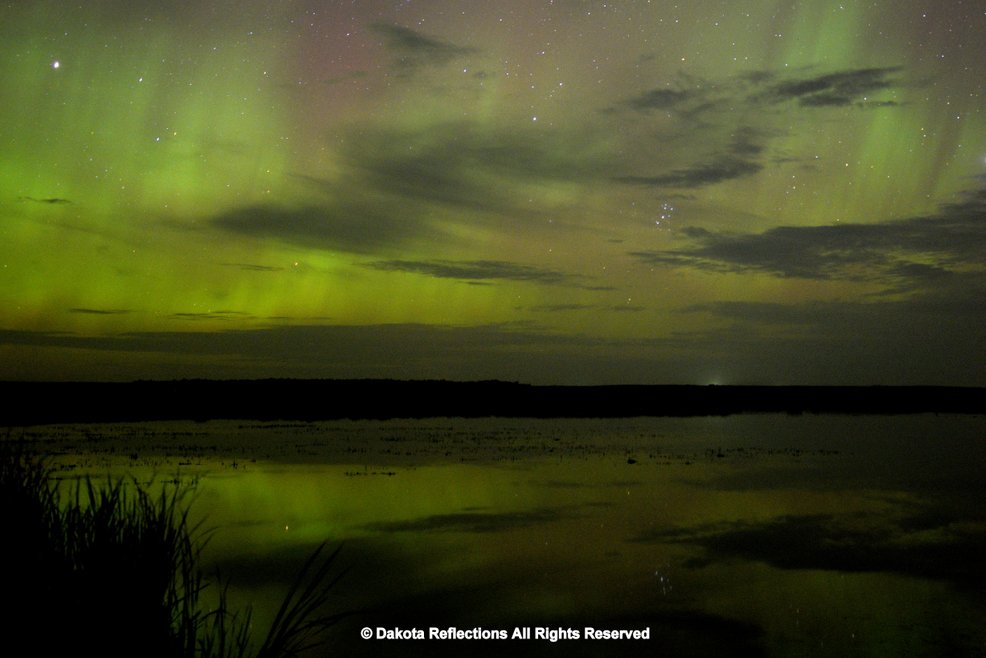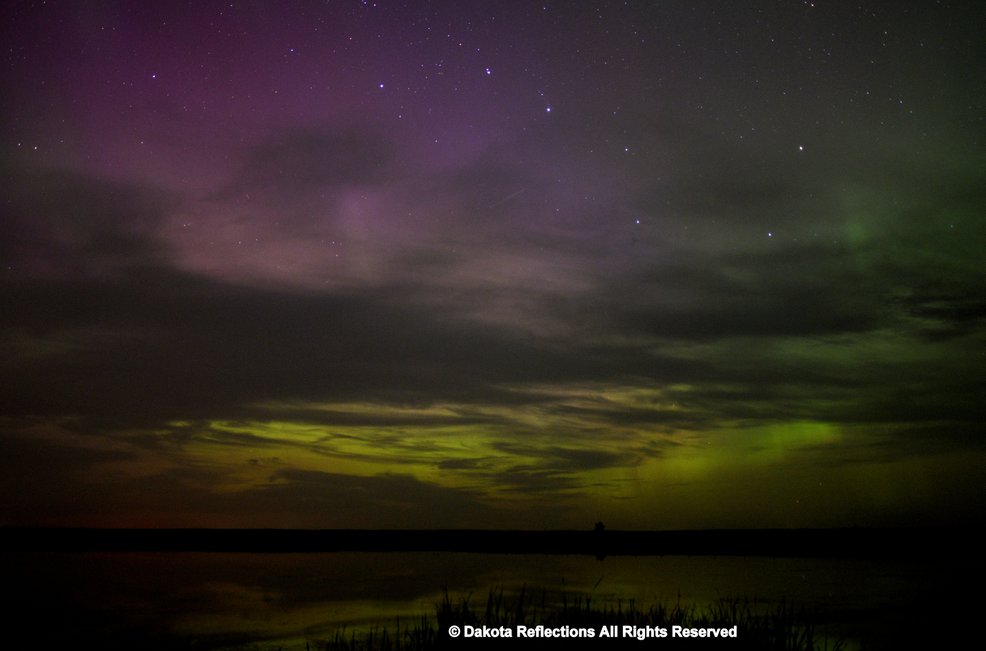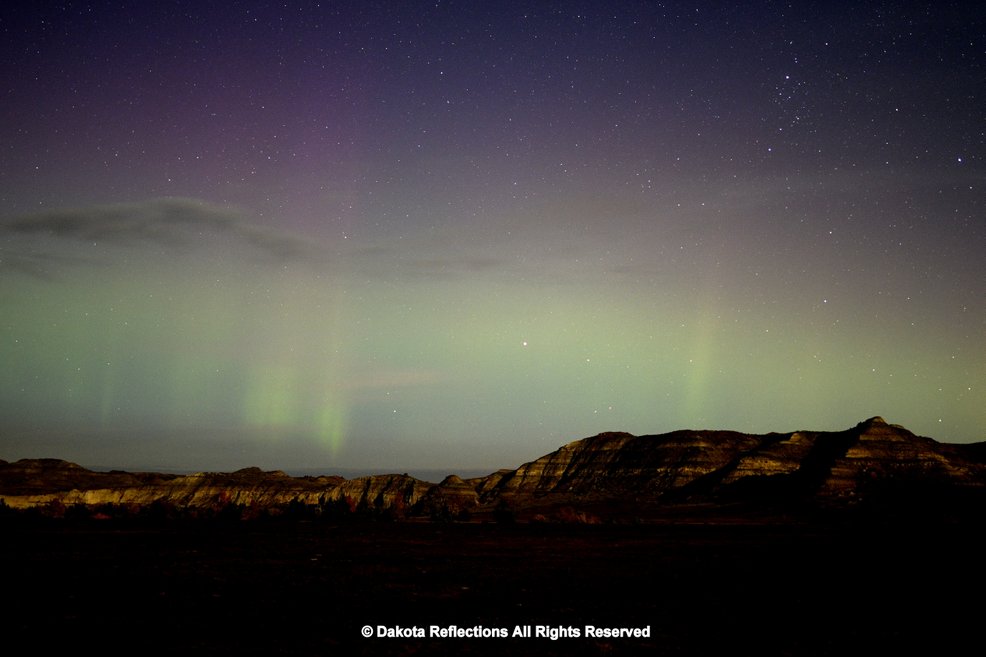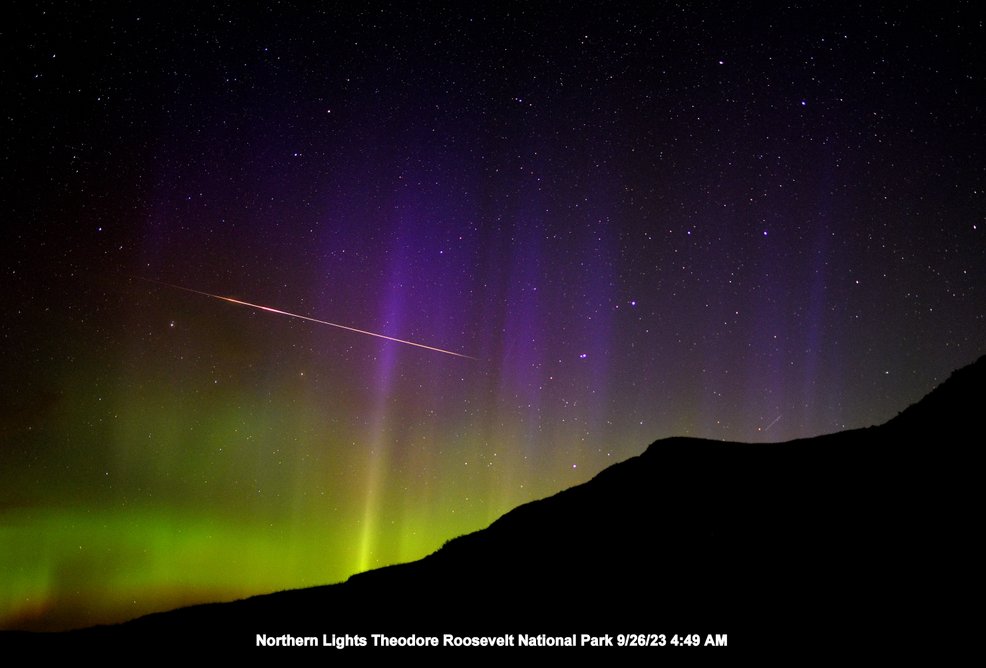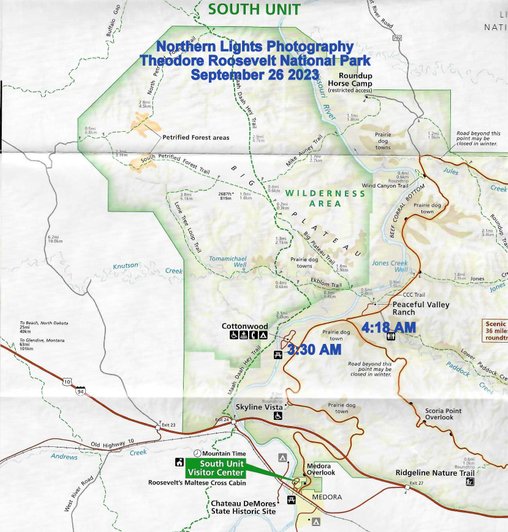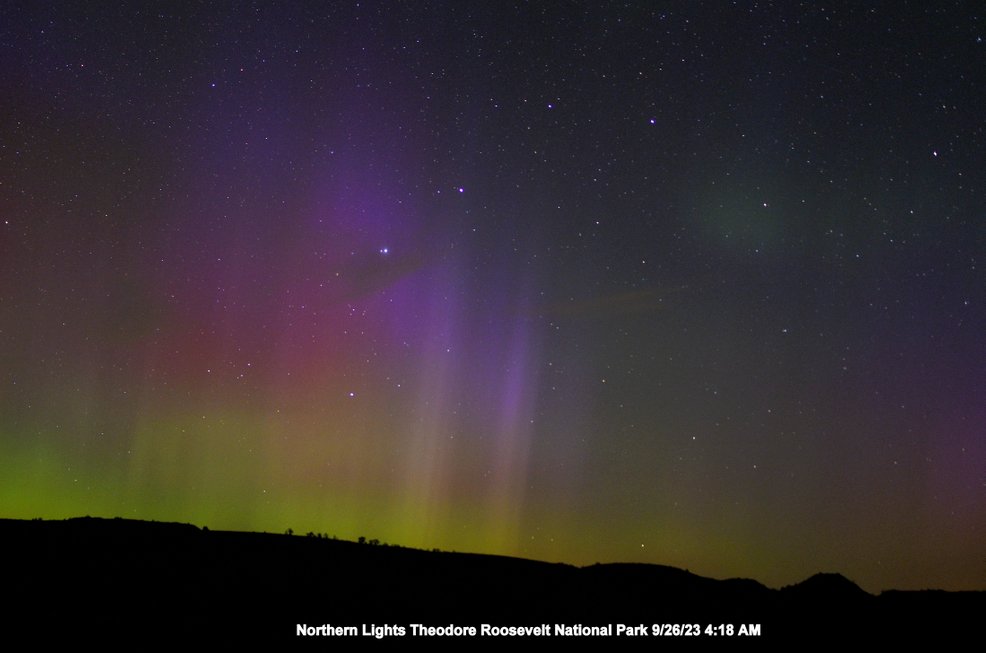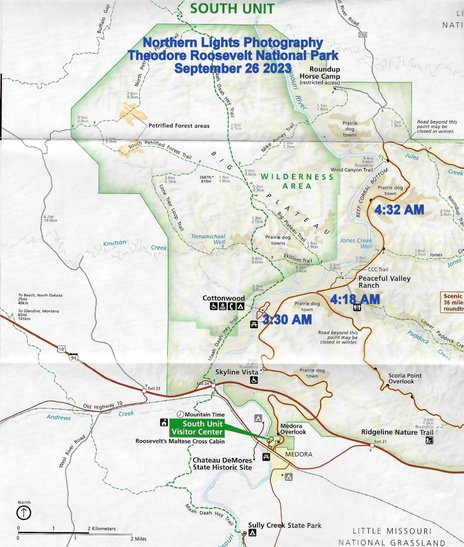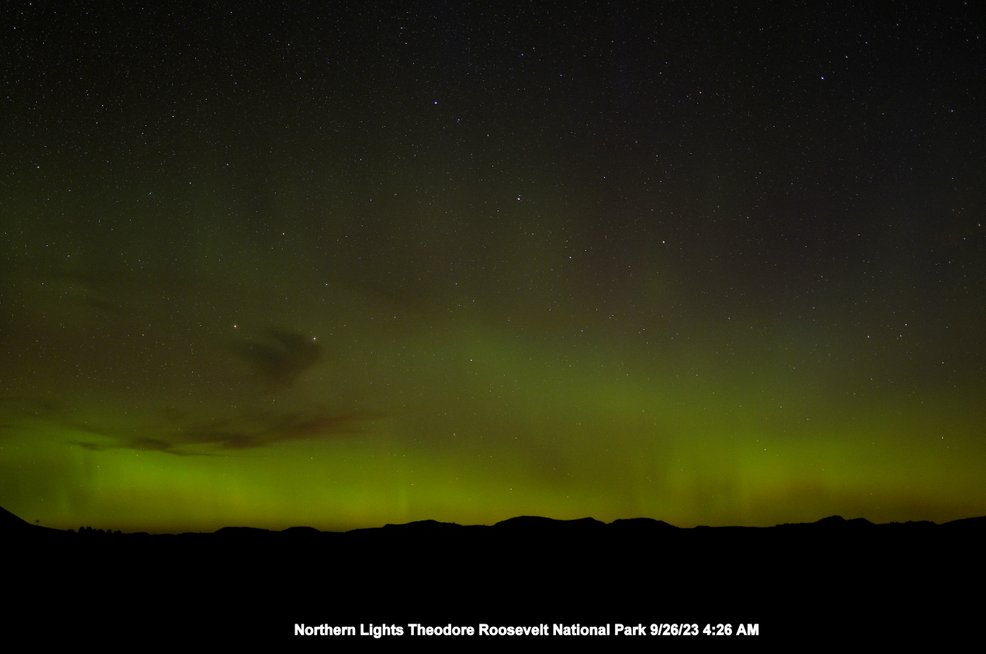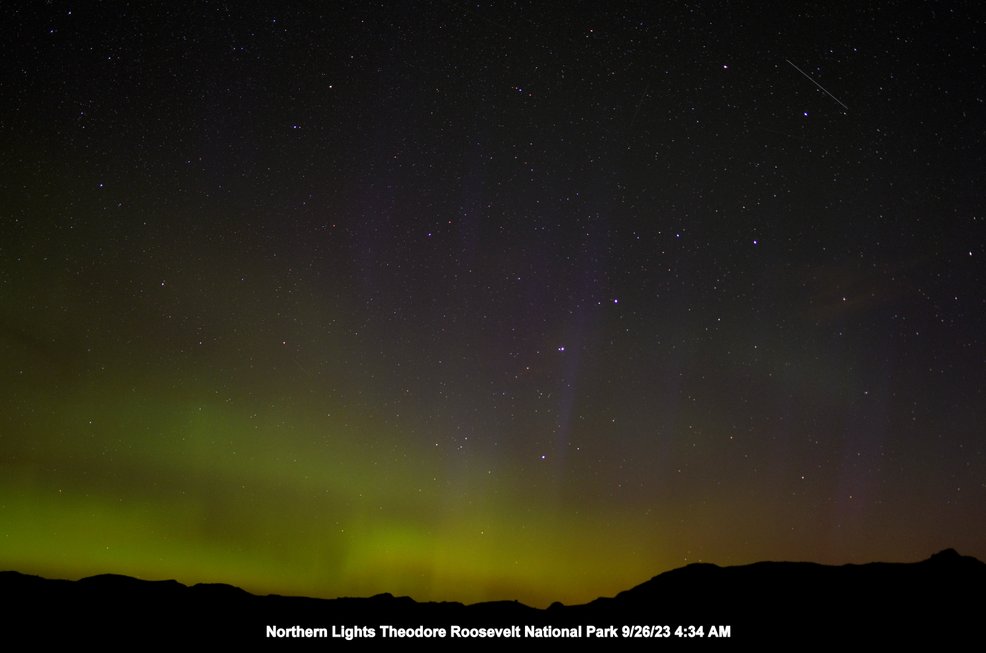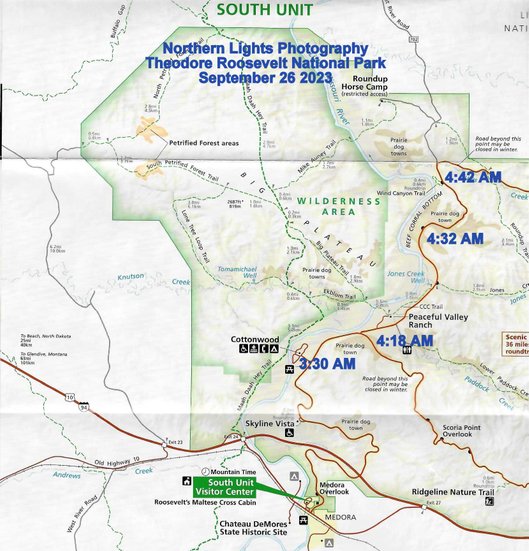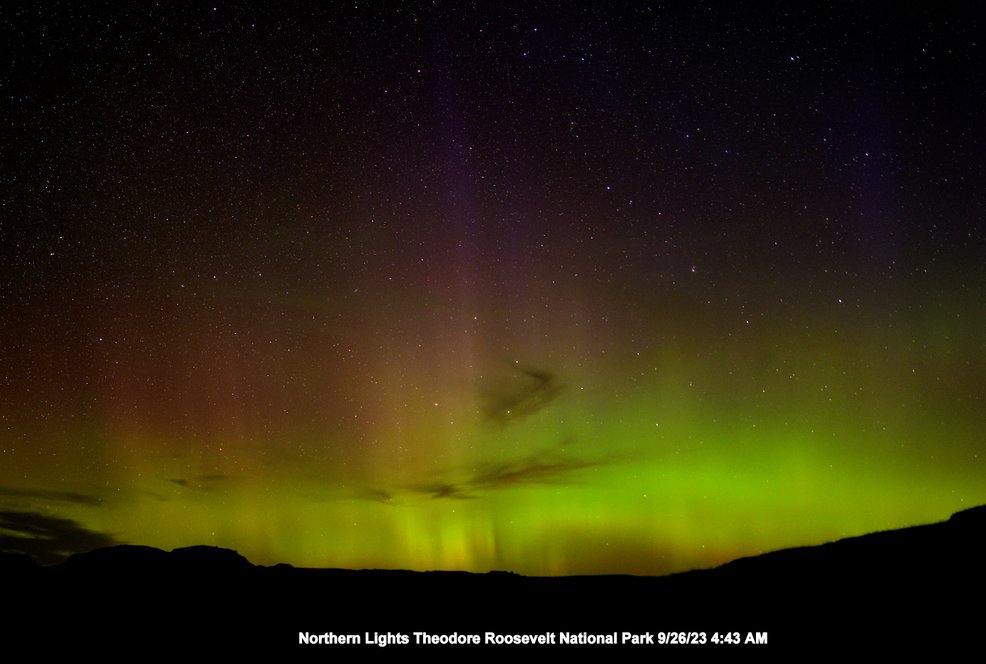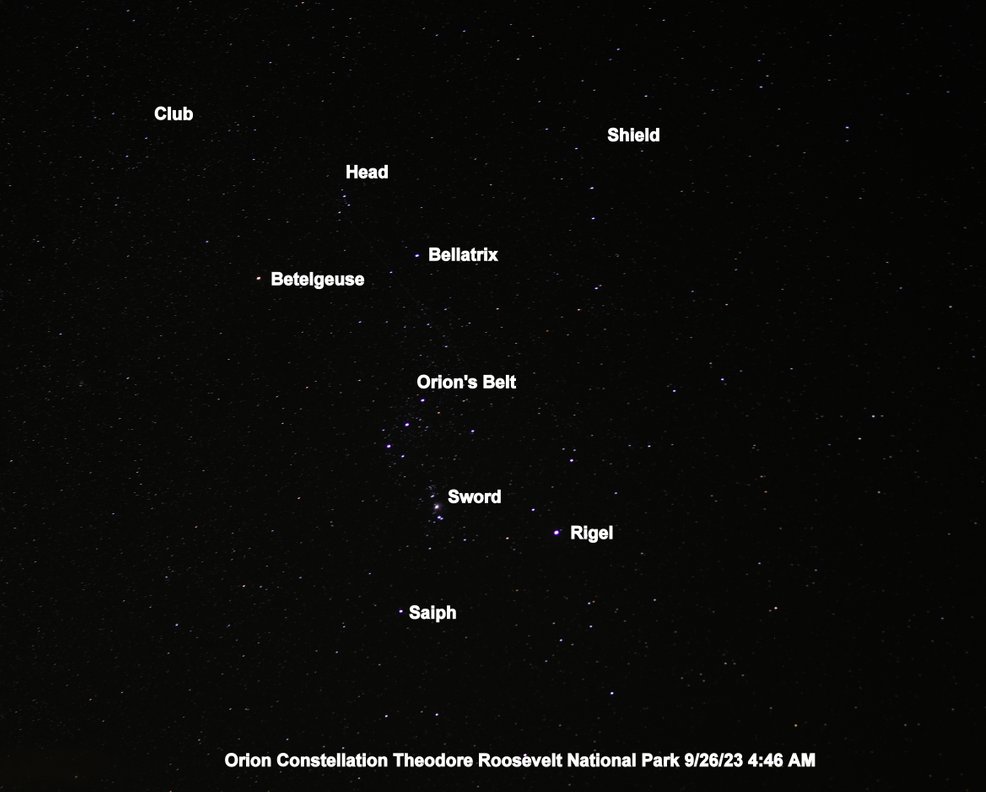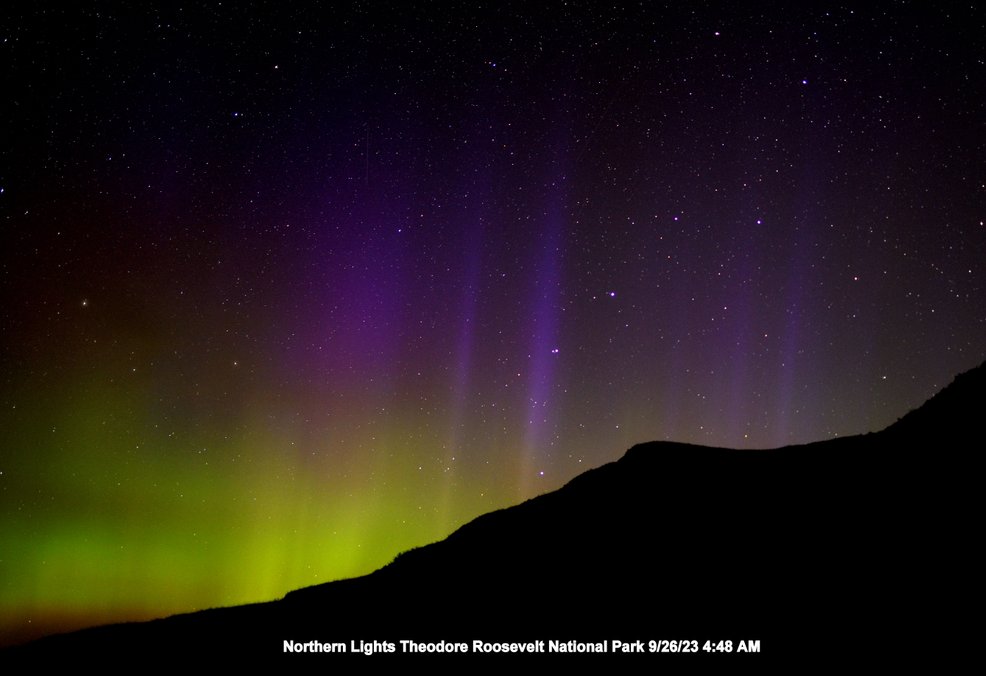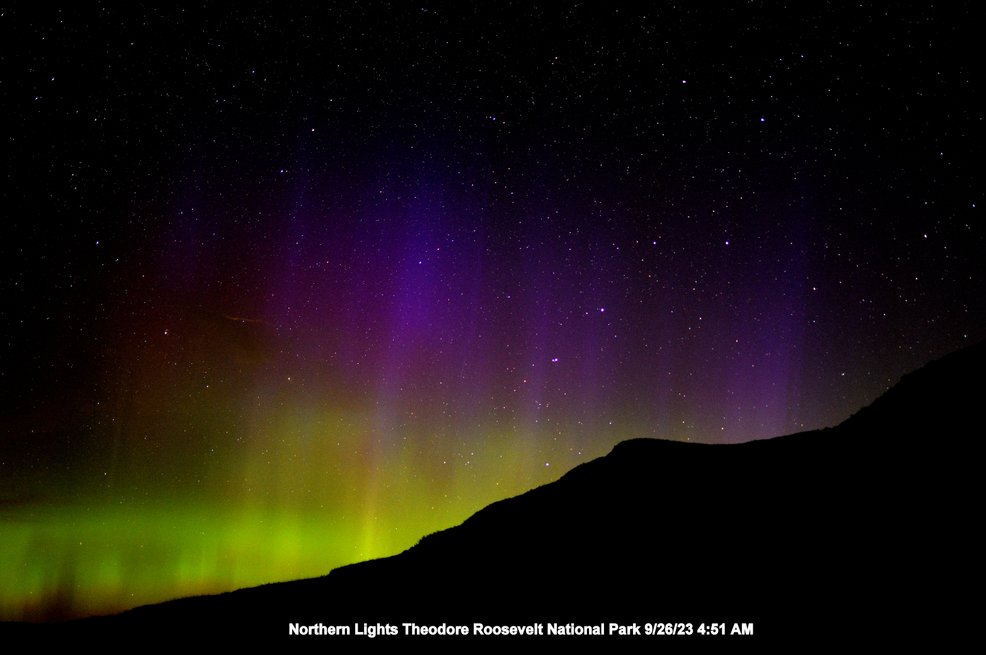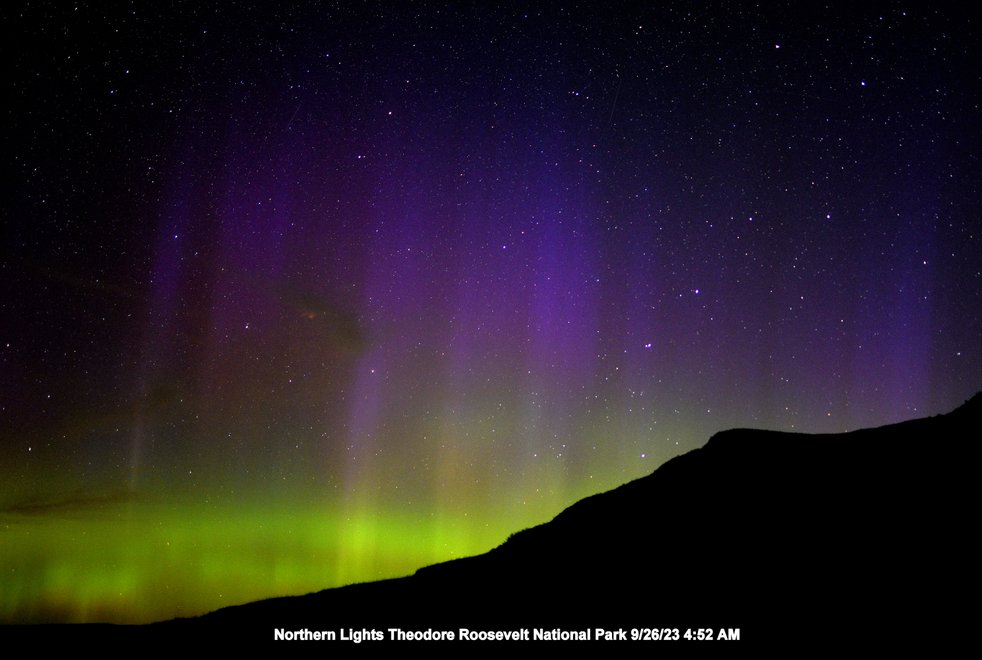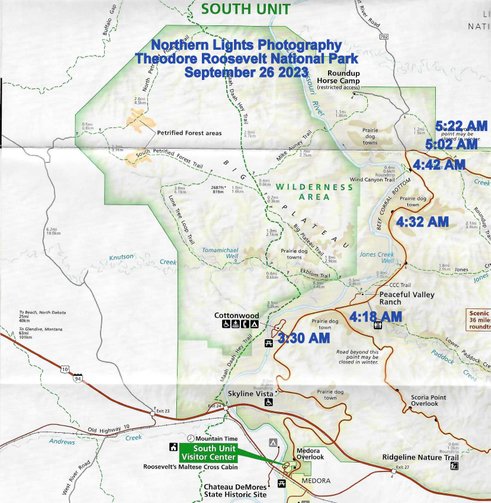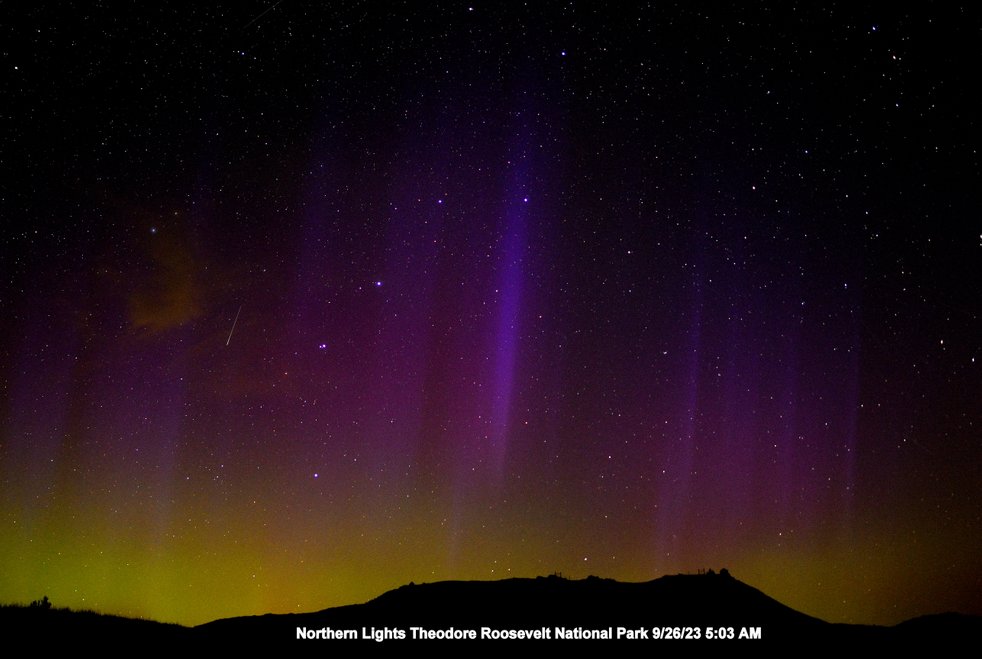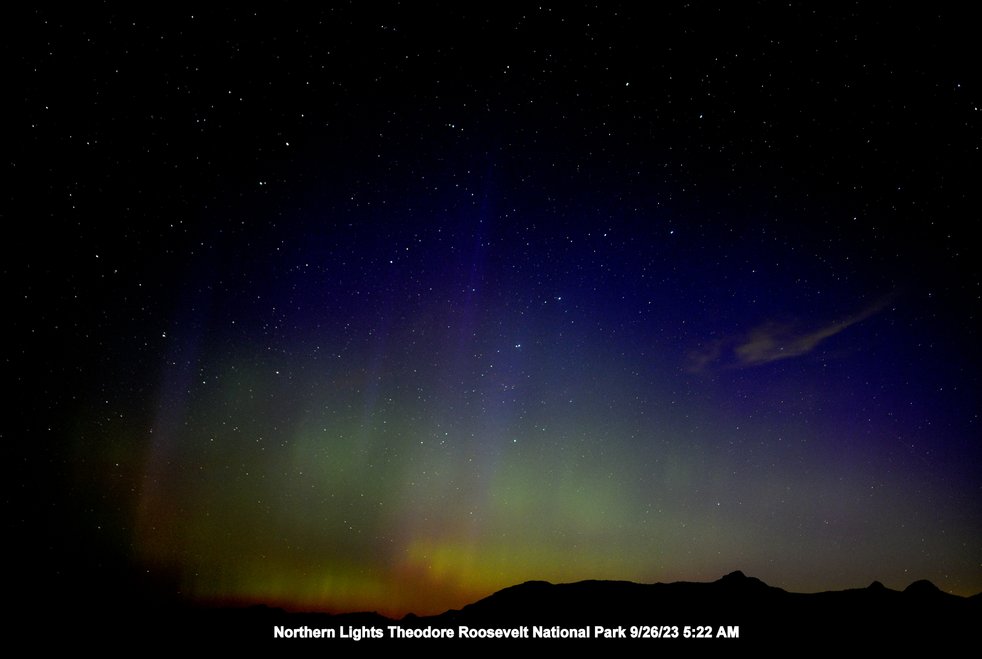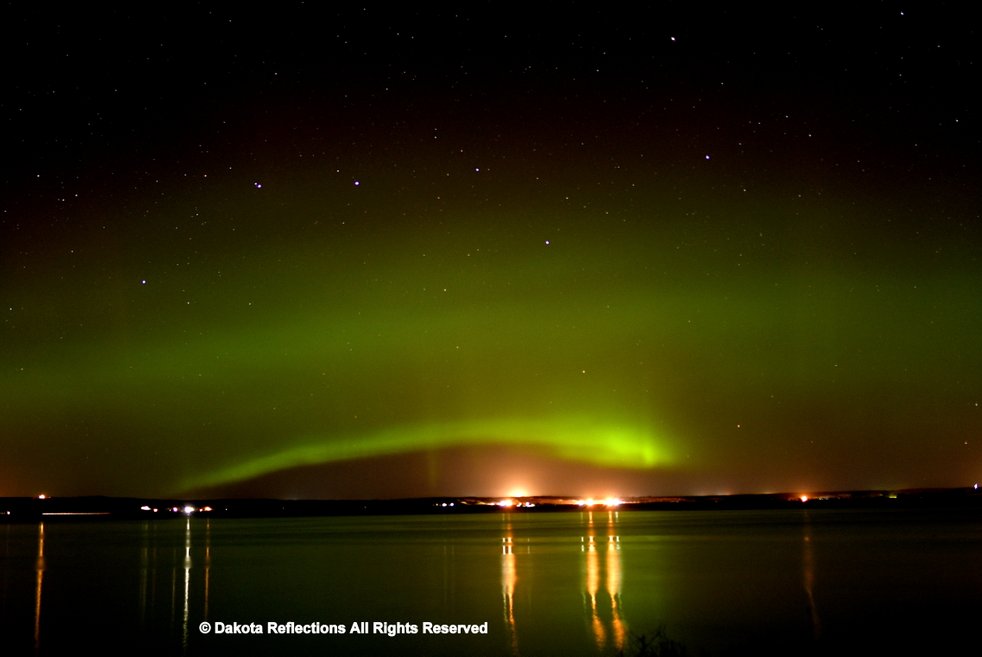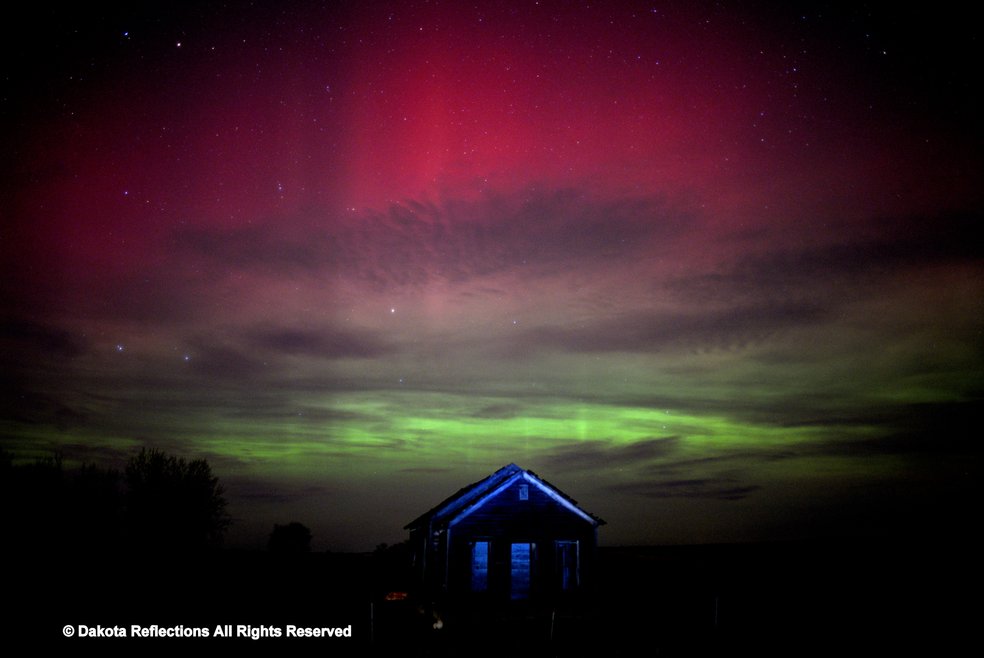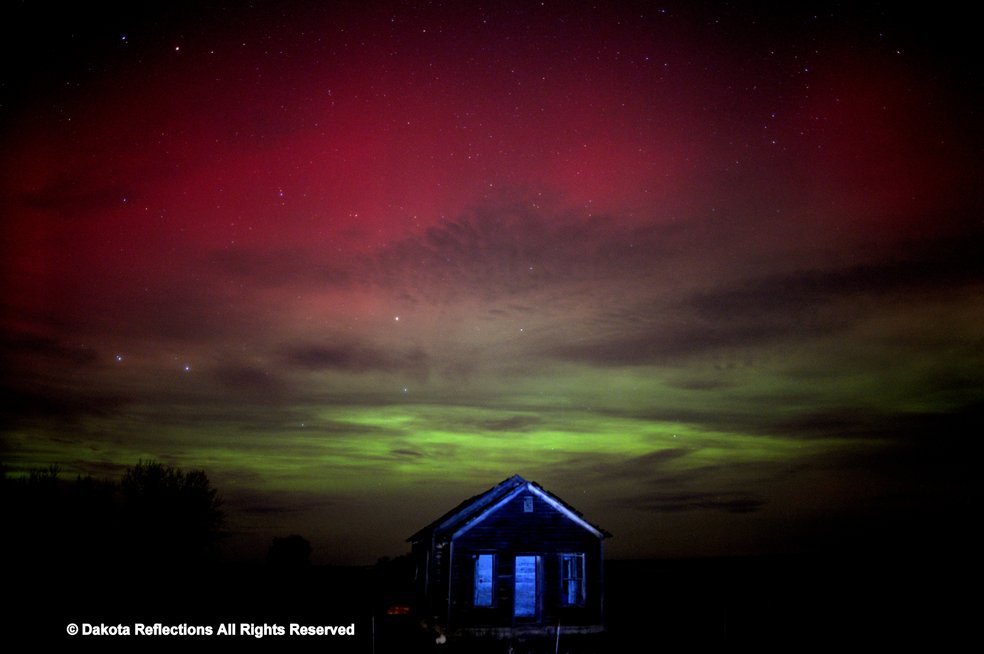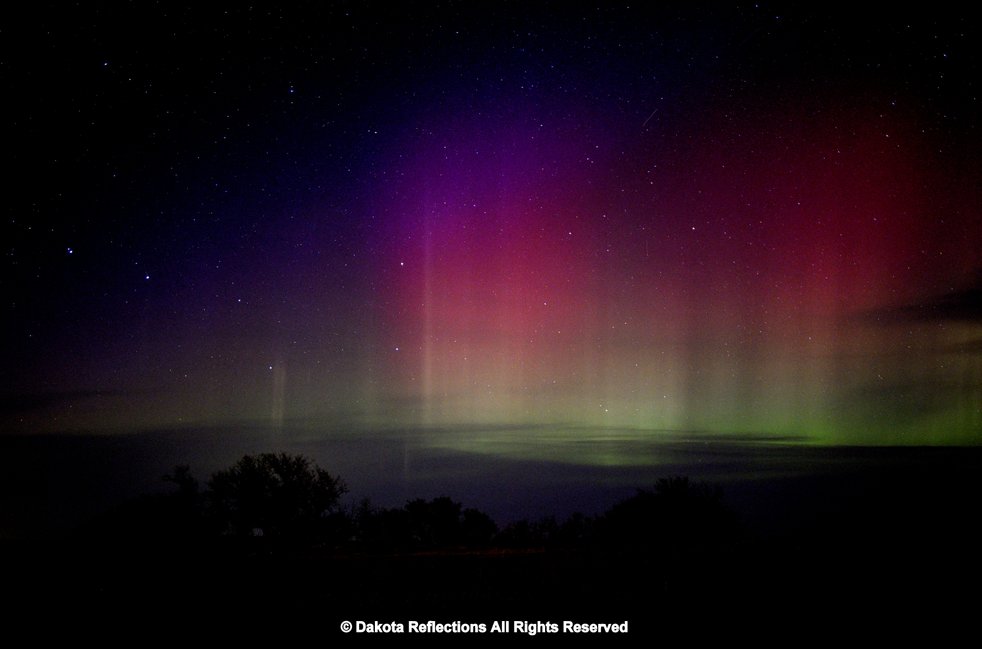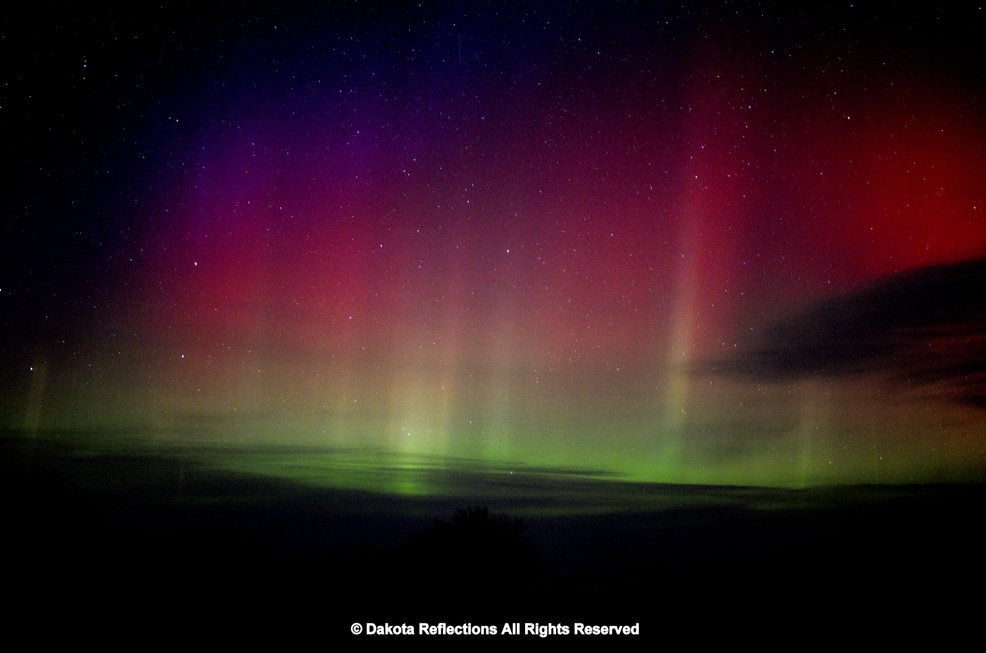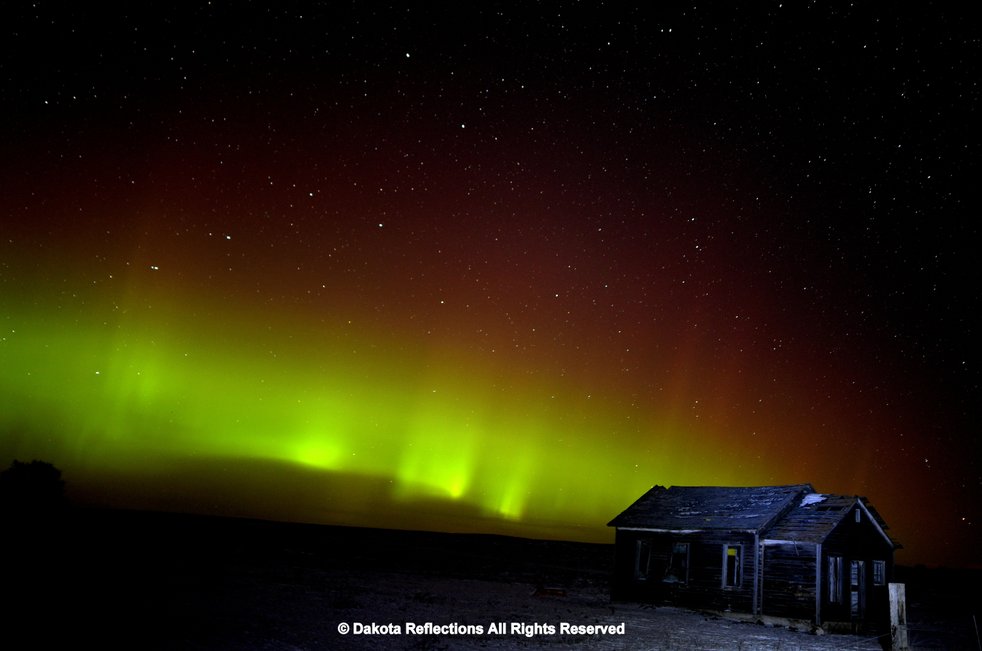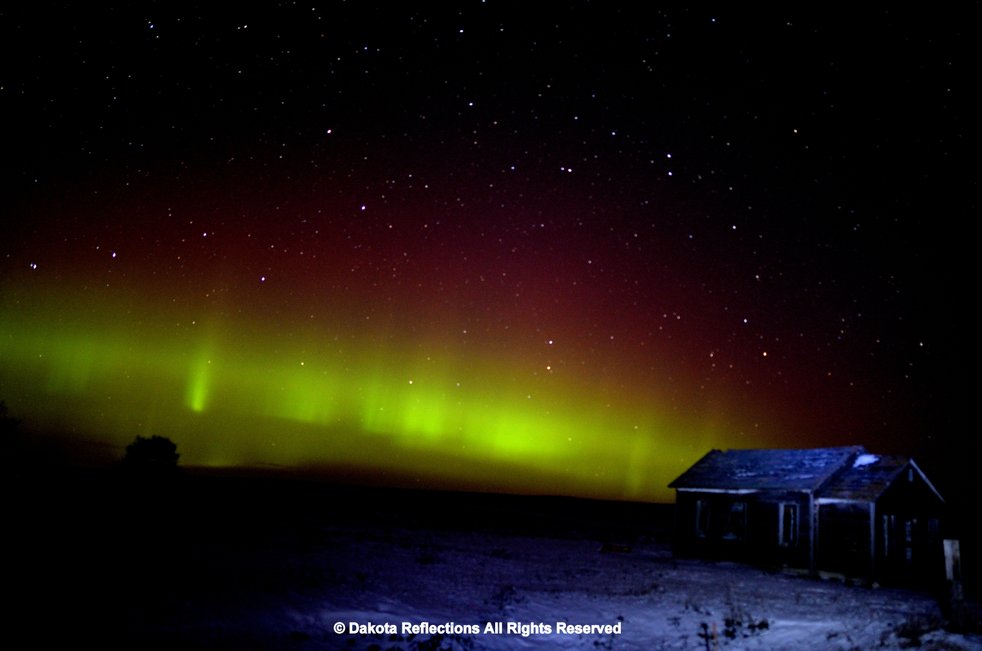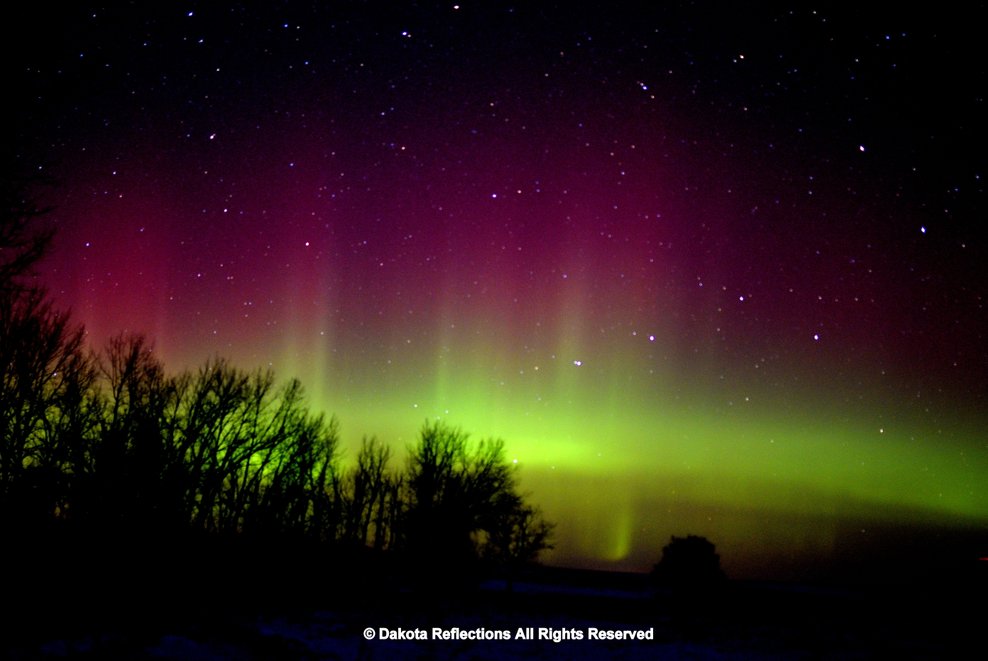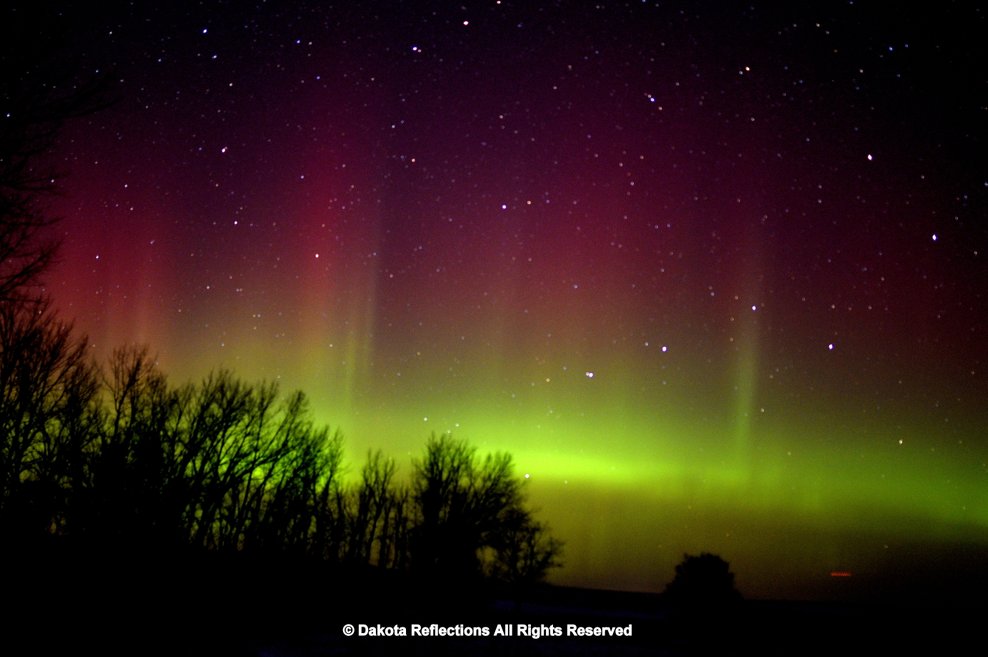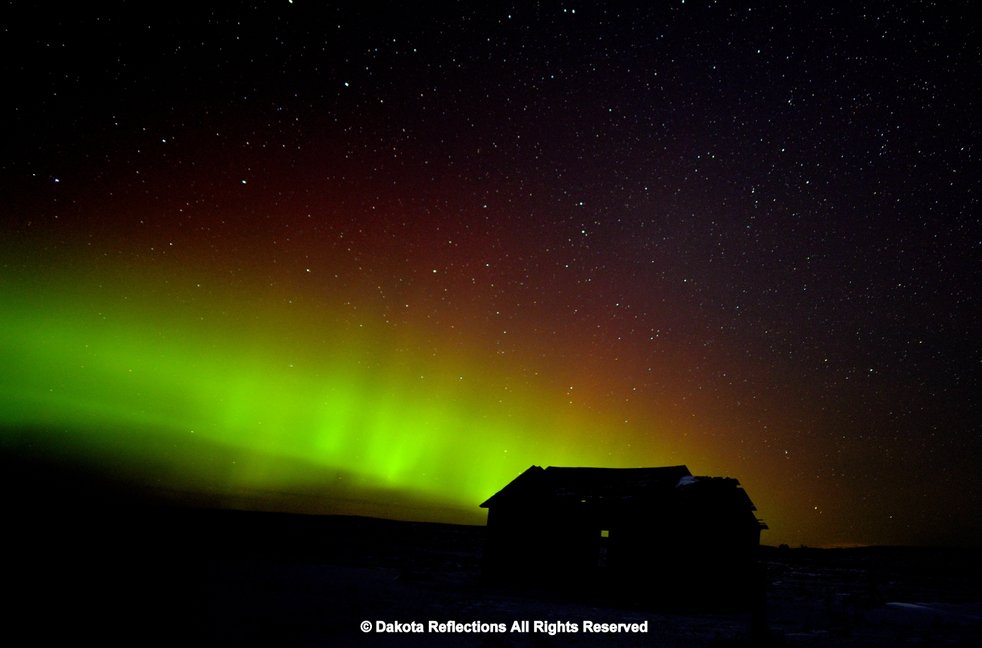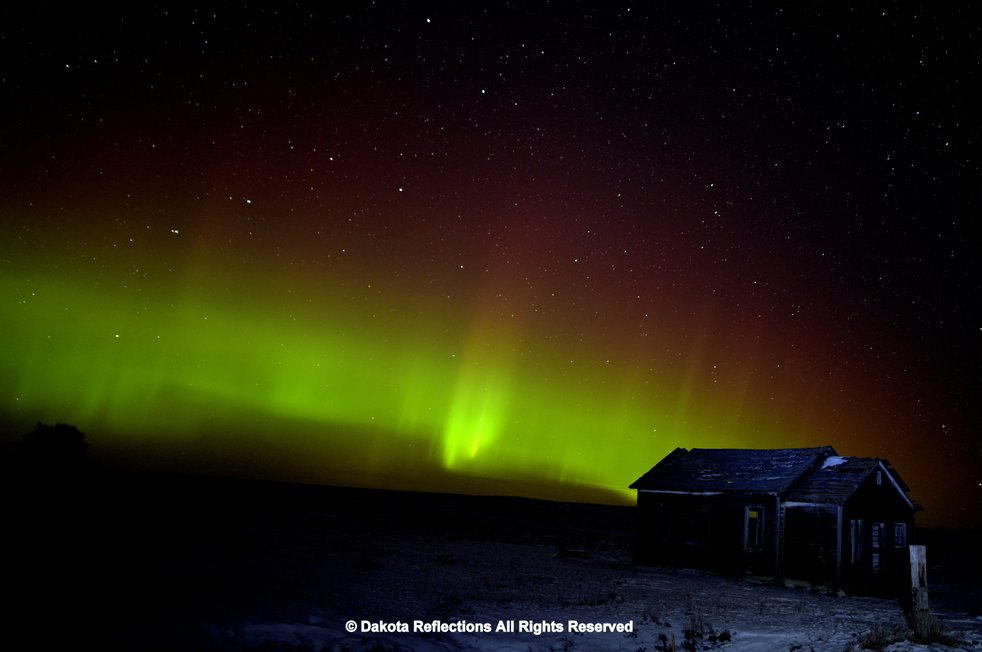Dakota Reflections
Dakota Night Skies
Comet Neowise
Theodore Roosevelt National Park, North Dakota
July 18, 2020
Comet neowise.
C/2020 F3 (NEOWISE) or Comet NEOWISE is a comet discovered on March 27, 2020, by astronomers during the NEOWISE mission of the Wide-field Infrared Survey Explorer (WISE) space telescope. It has the systematic designation C/2020 F3, indicating a non-periodic comet which was the third discovered in the second half of March 2020.
For observers in the northern hemisphere, in the morning, the comet appears very low above the north-eastern horizon, below Capella. In the evening, the comet can be seen low in the north-western sky. The comet can be seen in the morning and evening because it is circumpolar north of the 45th parallel north. On July 17, Comet NEOWISE entered the constellation of Ursa Major, below the asterism of the Big Dipper (The Plough).
Its closest approach to Earth will occur on July 23, 2020, 01:14 UT, at a distance of 0.69 AU (103 million km; 64 million mi) while located in the constellation of Ursa Major.
By early July, Comet NEOWISE had brightened to magnitude 1, far exceeding the brightness attained by previous comets, C/2020 F8 (SWAN), and C/2019 Y4 (ATLAS). By July, it also had developed a second tail. The first tail is blue and made of gas and ions. There is also a red separation in the tail caused by high amounts of sodium. The second twin tail is a golden color and is made of dust, like the tail of Comet Hale–Bopp.
On July 13, 2020, a sodium tail was confirmed by the Planetary Science Institute's Input/Output facility. Sodium tails have only been observed in very bright comets like Hale–Bopp and sungrazer C/2012 S1 (ISON). By July 5, NASA's Parker Solar Probe had captured an image of the comet, from which astronomers also estimated the diameter of the comet nucleus at approximately 5 km (3 mi).
https://en.wikipedia.org/wiki/C/2020_F3_(NEOWISE)
Comet Neowise
Theodore Roosevelt National Park, North Dakota
July 18, 2020
Big Dipper is seen in upper left central of photograph
Comet Neowise
Theodore Roosevelt National Park, North Dakota
Photo of the Day- July 18, 2020
One of the most fascinating details about Comet NEOWISE is that it won't return to our skies for another 6,800 years. But that's not the only thing that makes this icy space rock special. Comets, often nicknamed "cosmic snowballs," are icy, rocky objects made up of ice, rock and dust. These objects orbit the sun, and as they slip closer to the sun most comets heat up and start streaming two tails, one made of dust and gas and an "ion tail" made of electrically-charged gas molecules, or ions.
As a comet nears the sun, it warms up and material pulls away from the surface into a tail. Often, dust is pulled away along with gases from sublimating (going directly from solid to a gas) ice. This dust tail is the sweeping trail seen in most comet images. Comets also have an ion tail made up of ionized gas blown back by the solar wind.
The comet is traveling at about 40 miles per second (that's about 144,000 mph, or 231,000 km/h).
https://www.space.com/comet-neowise-strange-facts.html
Comet Neowise
Theodore Roosevelt National Park, North Dakota
July 18, 2020
Comet Neowise
Theodore Roosevelt National Park, North Dakota
July 18, 2020
Why does Comet Neowise have Two Tails?
First documented by Tycho Brahe (1546- 1601) in the late 1500s, comets have two tails, both always pointing directly away from the sun. The main tail on Neowise's right appears grey/white in color. The second tail on the left is faint, blue and in a straight line. The main tail is caused by the sun's radiation expelling dust from the comet. The smaller tail is caused by the sun's ultraviolet light ionizing carbon monoxide and creating an ion tail. Comet Neowise is 3 miles in diameter, traveling at 144,000 mph, and will return in 6,800 years!
Comet Neowise
Theodore Roosevelt National Park, North Dakota
July 18, 2020
Comet Neowise
Theodore Roosevelt National Park, North Dakota
July 18, 2020
Comet Neowise
Petrified Forest, Theodore Roosevelt National Park, North Dakota
Photo of the Day- July 24, 2020
Constellation Cassiopeia
Theodore Roosevelt National Park, North Dakota
July 18, 2020
Constellation Cassiopeia
Petrified Forest, Theodore Roosevelt National Park, North Dakota
July 24, 2020
Milky Way
Theodore Roosevelt National Park, North Dakota
July 18, 2020
Milky Way
Theodore Roosevelt National Park, North Dakota
July 18, 2020
Milky Way
Theodore Roosevelt National Park, North Dakota
July 18, 2020
Milky Way
Theodore Roosevelt National Park, North Dakota
July 18, 2020
Milky Way
Petrified Forest, Theodore Roosevelt National Park, North Dakota
July 24, 2020
Observation Blind
Painted Woods Wildlife Management Area, McLean County
August 15, 2020
This photograph was taken on Saturday night, photo of the day for August 15, 2020. In the top center, the bright light is the planet Jupiter. To its left is the planet Saturn. The glow in the left lower area is from the lights of Bismarck. The asterism "The Teapot" is to the lower right of Jupiter and is composed of the brightest stars of the constellation Sagittarius. To the right of "The Teapot" is the Milky Way.
Southern Sky
Painted Woods Wildlife Management Area, McLean County
Photo of the Day- August 15, 2020
Saturn and Jupiter Conjuction!
Saturn and Jupiter and Jupiter's Moons
Callisto, Io, Europa and Ganymede
Burleigh County, North Dakota
was cloudy after December 19 and I was unable to photograph on December 21
Photo of the Day- December 19, 2020
Moonset at Sunrise
Burleigh County, North Dakota
Photo of the Day- 2/26/2021
Sometimes, when the moon is setting, it will pick up some reddish light (longer wavelength gets through our atmosphere better) from the sunrise.
Mars and the Seven Sisters
Burleigh County
March 3, 2021
On March 3, 2021, the red planet Mars and the famous Pleiades star cluster – also known as the Seven Sisters – staged their closest conjunction on the sky’s dome until 2038. Mars swung 2.6 degrees south of the Pleiades, which appeared on our sky’s dome as a tiny, misty dipper of stars. They were a lovely sight in the evening sky. It was the closest Mars-Pleiades conjunction since January 20, 1991, when Mars passed 1.7 degrees south of the Pleiades. Looking ahead, Mars and the Pleiades won’t be as close again as they are this year until February 4, 2038. Mars will swing 2.0 degrees south of the Pleiades that year.
https://earthsky.org/tonight/closest-mars-pleiades-conjunction-until-2038
The Pleiades also known as the Seven Sisters and Messier 45, is an open star cluster containing middle-aged, hot B-type stars in the north-west of the constellation Taurus. It is among the star clusters nearest to Earth, it is the nearest Messier object to Earth, and is the cluster most obvious to the naked eye in the night sky. The cluster is dominated by hot blue and luminous stars that have formed within the last 100 million years. Reflection nebulae around the brightest stars were once thought to be left over material from their formation, but are now considered likely to be an unrelated dust cloud in the interstellar medium through which the stars are currently passing.
https://en.wikipedia.org/wiki/Pleiades
The Pleiades were the seven daughters of the titan Atlas and the sea-nymph Pleione born on Mount Cyllene. After Atlas was forced to carry the heavens on his shoulders, Orion began to pursue all of the Pleiades, and Zeus transformed them first into doves, and then into stars to comfort their father. The constellation of Orion is said to still pursue them across the night sky.
https://en.wikipedia.org/wiki/Pleiades_(Greek_mythology)
Northern Lights
Long Lake National Wildlife Refuge, North Dakota
3/30/2022
Northern Lights
Long Lake National Wildlife Refuge, North Dakota
3/30/2022
Northern Lights
Long Lake National Wildlife Refuge, North Dakota
3/30/2022
Northern Lights
Long Lake National Wildlife Refuge, North Dakota
3/30/2022
Northern Lights
Long Lake National Wildlife Refuge, North Dakota
Photo of the Day- 3/30/2022
Northern Lights
Long Lake National Wildlife Refuge, North Dakota
3/30/2022
Northern Lights
Long Lake National Wildlife Refuge, North Dakota
3/30/2022
Refuge Headquarters
Northern Lights
Long Lake National Wildlife Refuge, North Dakota
3/30/2022
Northern Lights
Long Lake National Wildlife Refuge, North Dakota
3/30/2022
Northern Lights
Long Lake National Wildlife Refuge, North Dakota
3/30/2022
Oxygen gives off the fluorescent green and yellow color of the aurora (most common) when hit by electrons in the solar system. Nitrogen causes blue or red colours and sometimes pink, while neon turns them orange.
Early Morning Northern Lights!
Burleigh County, North Dakota
Photo of the Day April 1, 2022
Eclipse!
Lunar Eclipse
Theodore Roosevelt National Park, North Dakota
Photo of the Day- May 15, 2022
Blood Moon!
Lunar Eclipse
Theodore Roosevelt National Park, North Dakota
May 15, 2022
When the sun’s rays reach the Earth, much of the blue and green light is scattered, while the orange and red colors remain visible, which is why the moon turns a reddish hue and is often referred to as the “blood moon" during a total lunar eclipse.
Badlands, Big Dipper and Aurora Borealis!
Northern Lights
Theodore Roosevelt National Park, North Dakota
Photo of the Day- September 3, 2022
2023 Photos
Midnight Special!
Coronal mass ejection (CME) produced severe G4 class geomagnetic storm!
Northern Lights
Burleigh County, North Dakota
April 23, 2023
Northern Lights
Burleigh County, North Dakota
April 23, 2023
Northern Lights
Burleigh County, North Dakota
April 23, 2023
A Pleiades Reflection!
The Seven Sister at Clear Lake!
Northern Lights
Burleigh County, North Dakota
Photo of the Day- September 18, 2023
Northern Lights and Big Dipper
Burleigh County, North Dakota
September 18, 2023
Northern Lights with 2/3 Moonlight
Theodore Roosevelt National Park, North Dakota
September 24, 2023
The Story behind the Photo!
What are the Odds?
Once in a Lifetime Photo!
Meteor (Shooting Star) Northern Lights Big Dipper and Badlands Butte
Theodore Roosevelt National Park, North Dakota
Photo of the Day- September 26, 2023
Photo of the Month September 2023
On September 20, 2023, I drove from Bismarck to Watford City (190 miles) to visit the McKenzie County Health System. On the way, I took a detour to the south unit of Theodore Roosevelt National Park near Medora to visit with the Cottonwood Campground host. I had served for over 2 months in 2022 as a host at that campground. I was informed that the campground host had left 2 weeks early and that the park staff would like me to serve as an emergency fill in campground host. I agreed to do so. I then went to Watford City and returned to Bismarck on the evening on September 21. I left Bismarck in the morning of September 22 and drove back to Theodore Roosevelt National Park with my travel trailer
The northern lights were predicted to be good on the evenings of September 24 and 25. Unfortunately, there was a 3/4 moon in the evening which washed out the northern lights on September 24. When I went to sleep in the trailer on September 25, the moon was very bright but I resolved to get up during the night to see if the moon had set.
I awoke at 3:30 AM on September 26 and stuck my head out of the trailer and saw that the night sky was very dark as the moon had set. I dressed and stepped out of the trailer and saw northern lights low to the horizon. I got in my car and drove north to the first prairie dog town and set up my camera and tripod.
The first prairie dog town overlooked the Little Missori River. The northern lights were not very extensive but had good color. I decided to drive up to the next prairie dog town which was very large and was in a broad section of a valley, allowing a good view of the sky.
The northern lights at the second prairie dog town were intensifying. I thought that I could go further north to Wind Canyon and perhaps photograph the northern lights to the northwest and get reflections from the Little Missouri River. The Big Dipper was to the northeast.
When I arrived at Wind Canyon, the northern lights were directly to the north so hiking to the overlook would not give good photos and would be perhaps dangerous. I decided to set up in the parking lot and photo the northern lights directly to the north as the colors were improving with oranges and purples!
The constellation Orion was behind me to the south. I quickly turned the camera around and took a photo.
When I turned the camera around to photograph the northern lights, I decided to point toward the Big Dipper to the slight northeast to include three items in the composition- northern lights, Big Dipper and the Badlands butte. This photo was a 15 second exposure at ISA 400 and f 1.4 with a 24 mm lens. After the 15 second exposure, the camera had a 20 to 30 second down time while the image was processed before showing up in the screen.
I then decided to change the camera settings to decrease the exposure time by increasing the ISO. The settings were a 10 second exposure at ISA 800 and f 1.4 with the 24 mm lens. Two seconds after pushing the shutter button, an unbelievable event happened. A meteor (shooting star) exploded into the sky and almost immediately disappeared. Fortunately, it occurred when the shutter open and in view of my recently repositioned camera.
I have only seen a couple of meteors in my life. When I have tried to photograph shooting stars during meteor showers, I have never been successful.
What are the odds? I was only in the park by happenstance.
I took several more photos as the colors were excellent then moved further north.
After several more photos in the north end of the park, the colors started to fade. I then returned to my trailer and began my morning hosting responsibilities
An unforgettable experience!!
Green Arc above Water!
Reflection from Lake Sakakawea
Northern Lights
Tobacco Garden Creek Recreation Area, North Dakota
Photo of the Day- November 12, 2023
Red Oval!
Intense Northern Lights and Oxygen Molecules at High Altitudes
Northern Lights
Burleigh County, North Dakota
Photo of the Day- December 1, 2023
Northern Lights
Burleigh County, North Dakota
December 1, 2023
Northern Lights
Burleigh County, North Dakota
December 1, 2023
Northern Lights
Burleigh County, North Dakota
December 1, 2023
Vestiges in Time!
Northern Lights, Big Dipper and an Abandoned School House
Northern Lights
Burleigh County, North Dakota
Photo of the Day- December 13, 2023
Photo of the Month- December 2023
Northern Lights
Burleigh County, North Dakota
December 13, 2023
Northern Lights
Burleigh County, North Dakota
December 13, 2023
Northern Lights
Burleigh County, North Dakota
December 13, 2023
Northern Lights
Burleigh County, North Dakota
December 13, 2023
Northern Lights
Burleigh County, North Dakota
December 13, 2023
Northern Lights
Burleigh County, North Dakota
December 13, 2023
Northern Lights
Burleigh County, North Dakota
December 13, 2023
Northern Lights
Burleigh County, North Dakota
December 13, 2023

